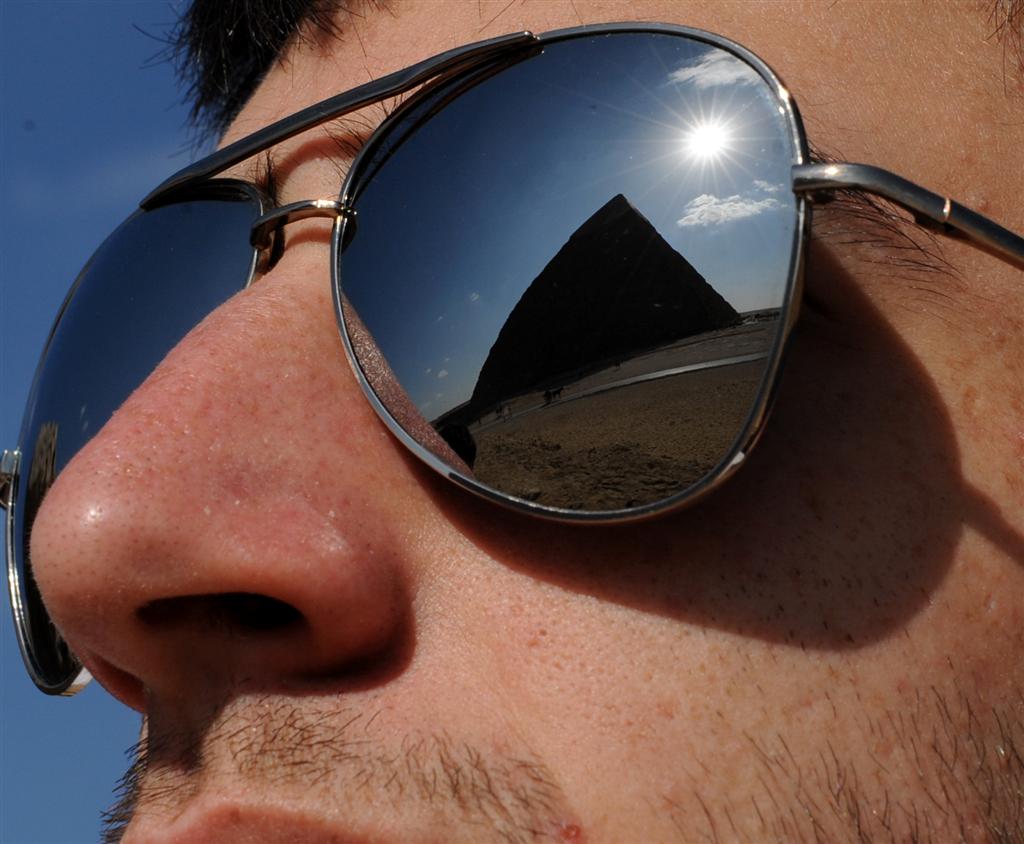

Middle East Experience
Part One: Our Guide To Cairo and The Upper Nile
Photos and Story by Tab Hauser tab@tabhauser.com
Authors Note: Most travel articles hit “highlights” -- but in this “mini-guide” to our trip to Egypt, Jordan and with a quick stop in Israel, I have tried to convey a sense to the reader that they were right there along with us! The rendering of details and brief site histories will offer a window into our trip. Please see the "If You Go" section on the bottom for practical tips and security concerns. See Part Two for "Jordan with a 30 hour stop in Jerusalem". For now, Welcome Aboard !
First Stop: Cairo
After several months of planning and a long overnight flight from New York our group of 4 parents and 5 children ranging in ages 15 to 21 arrived in Cairo. Upon arrival in Cairo, our rep from Wisdom Tours did a great job hustling us through the Cairo Airport visa and arrivals process and safely secured both us and our baggage aboard our bus in a record half-hour which. We even stopped at a local supermarket for a quick look at local ’ways and means’ and to get snacks before proceeding directly to the Egyptian Museum.
The Egyptian Museum was built in 1900 and houses many of Egypt’s prime antiquities. There are over 120,000 artifacts on display, and many more remain in storage. We oriented ourselves by first examining the chronology of the Egyptian Kingdoms, and then proceeded to the exhibits. We started with the King Tutankhamen (The Boy King) exhibit which by Providence lay undiscovered and thus undisturbed by looters down through the ages. After examining the other Pharaohs’ artifacts we entered the Royal Mummies Room and came face to face with 27 mummies. We greeted Ramses II up close and in person – he was very well preserved and all his facial features were clearly identifiable. We were almost surprised he didn’t spring to life with a friendly “Salaam and good day dear friends, come join me for mint tea!”
After touring the Museum and being tired and jet lagged we repaired to the Le Meridien hotel in Heliopolis for a late lunch… and then conked out. Three of us recharged enough by the evening to enjoy snacks of delicious olives and amazingly smooth hummus and good Egyptian beer.

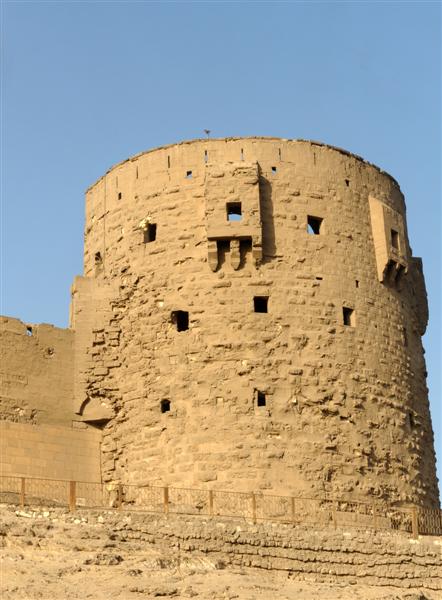
The Mosque of Muhammad Ali at the Citadel in Cairo
Our second day started with a good breakfast of Egyptian and western food at the hotel buffet. Afterwards our group, guide, driver and business suit wearing security officer boarded the bus and headed to The Citadel. The Citadel is an imposing structure on a hill whose construction commenced in 1176. As was the case at many of the historical sites, we were obliged to pass our bags through security. We then proceeded up a small hill to marvel at imposing domes and the ubiquitous minaret. After learning about the Citadel we continued through to the open court yard, where an ornate well was ready for ablutions by the faithful before prayers --and the broken clock tower, which was a gift from the French who had traded it for one of the Luxor obelisks – which now stands at Place de la Concorde in Paris… (Our tour guide expressed a certain PIQUE that her forebears had been swindled with this non-functional clock) We then toured the Mosque of Muhammad Ali, and were impressed with the interior height, depth and design. In one corner we saw light streaming in through the stained glass window high above, reminiscent of similar inspiring displays in European cathedrals, but substantially predating many of them. We then walked next door to the Qasr el-Gawwarah (aka the Jewel Palace). Here we saw the throne of Muhammad Ali and the bedroom set of Queen Eugenie, wife of Napoleon. (This furniture was originally in the palace in downtown Cairo -- which is now a Marriot Hotel.)
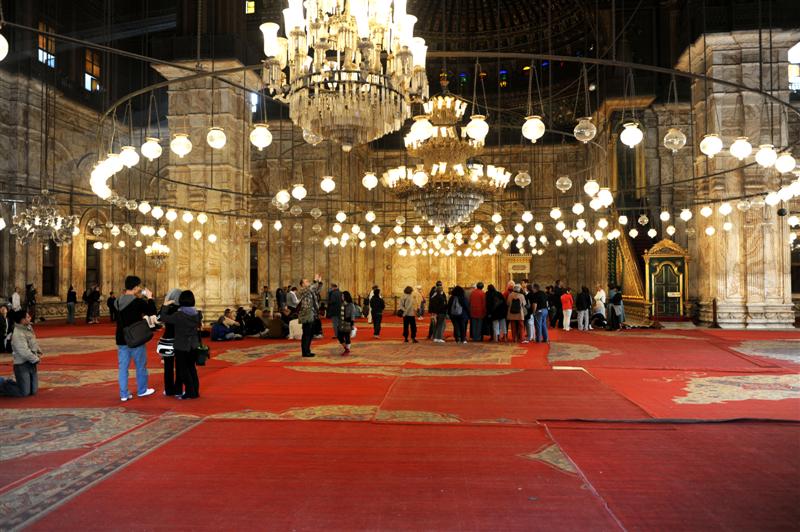
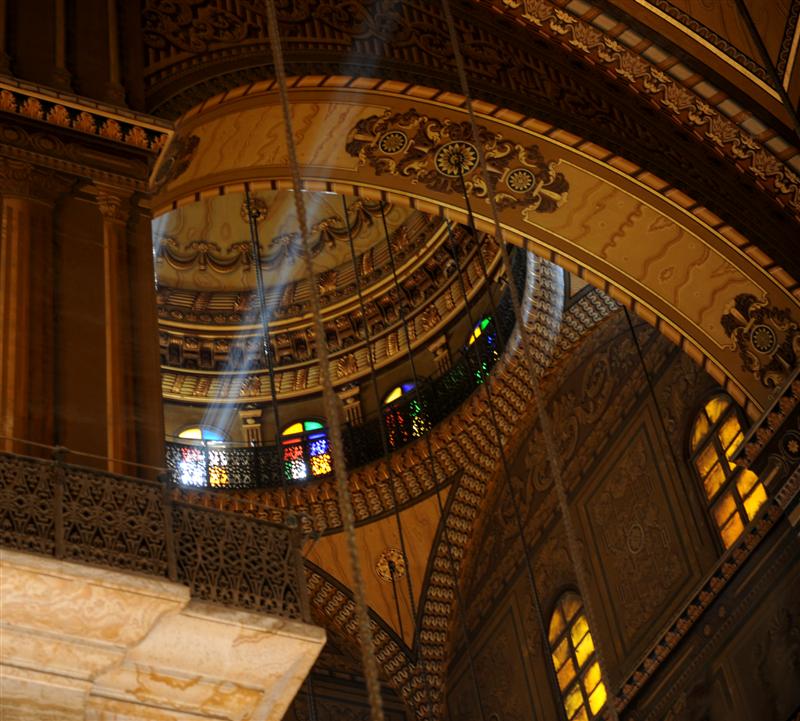
Inside Mosque Of Muhammad Ali Looking Up At Streaming Light
With great anticipation we then proceeded to a place we have known about our whole lives, a place which lives in popular culture through photos, stories, film and literature… a place indeed which is one of the Seven Wonders of the Ancient World! We were headed to the Great Pyramid of Khufu (Cheops) with its surrounding complex of smaller pyramids and ruins. We “oohed and aahed” at the Great Pyramid. We learned that wind erosion reduced the height of the Pyramid from 482ft to around 450ft, exposing the outer blocks of stone. The Pyramid is estimated to be constructed of 2.3 million blocks weighing an average of 2.75 tons each. Construction started around 2,560 BC -- making it not only one of the world’s oldest surviving structures, but also the tallest one for the next 3,800 years.
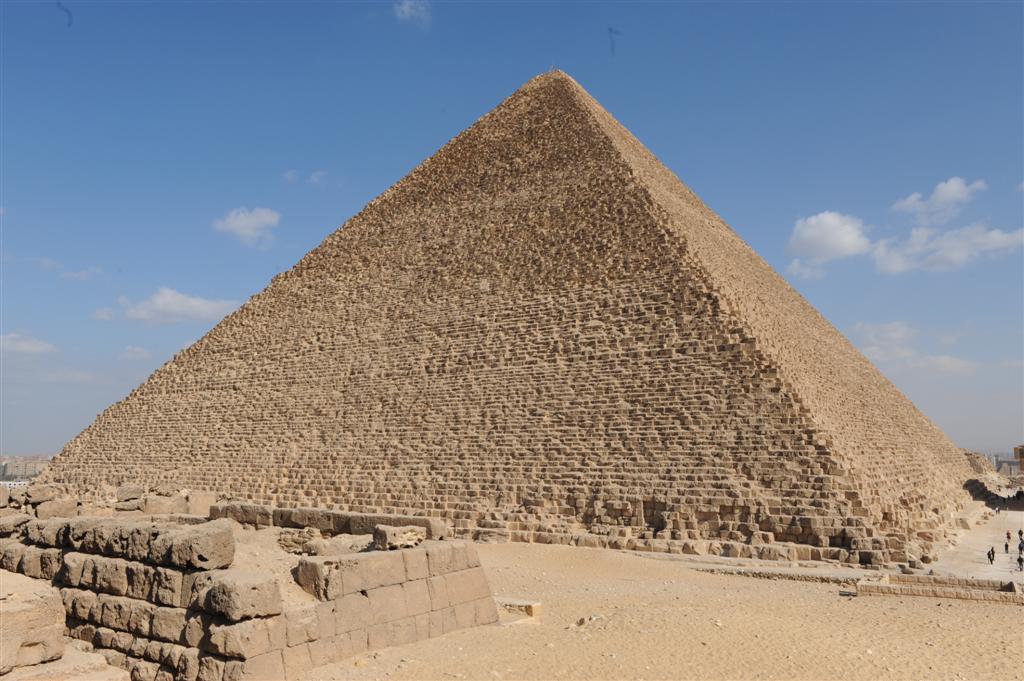

Pyramid of Khufu or The Great Pyramid Finding Solitude In Ruins Near Pyramids
Our guide briefed us on the history of the site, gave us 45 minutes to explore on our own, and sternly counseled us to NOT speak to any of the locals to avoid being harassed for baksheesh. She also advised us also to go down to the Queen’s tomb located next to the Great Pyramid as well. Our kids lead the way from the bus directly to the first stones, and they then proceeded to climb up a few. Their ascent was well underway until a guard blew his whistle.
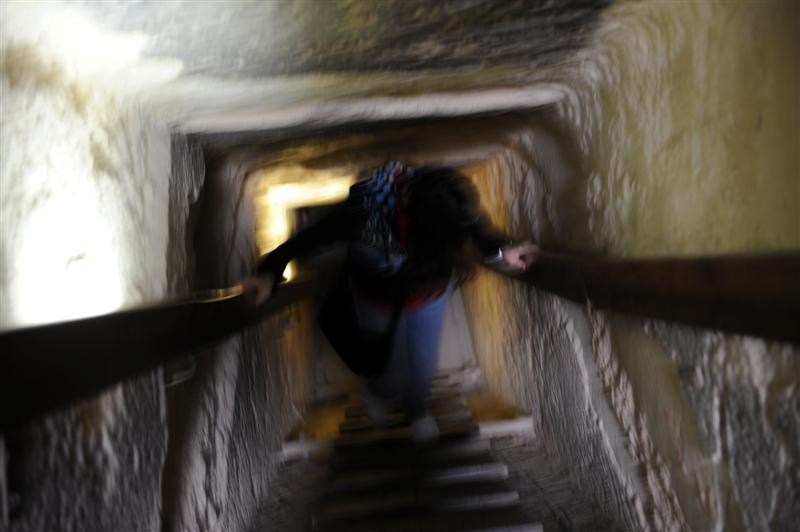
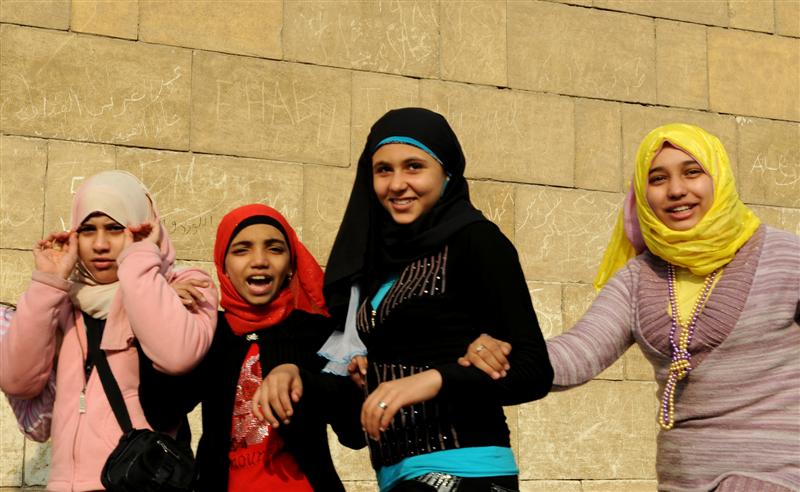
Going Near Vertical Into Queens Tomb, Giza Smiling Cairo School Girls On Field Trip
From the Pyramid we made our way down the steep secretive looking entrance to the Queen’s tomb. This involved a single file entrance negotiating narrow, steep low-hanging enclosures and a steep ladder descent into the Queen’s tomb inner sanctum. While whistling the theme from Indiana Jones, my daughter put her hands up against a large stone and proclaimed it be the signal stone which, when moved, would then reveal the secret entrance to the inner treasures. (Of course!) After clambering back up out of the tomb, we circled the Great Pyramid , proceeding to the next one called Khefren. From here we witnessed the dramatic view of the endless Egyptian desert stretching to infinity to the west. At this spot we were offered for camel rides, trinkets, and tours of ‘special points of interest…’… and over and over again for baksheesh. From the Pyramid of Khefren we walked through the ruins opposite the Great Pyramid; we enjoyed spending time in this area of decaying ruins because we had this section to ourselves, and with some serenity could begin to absorb the staggering antiquity all around us.
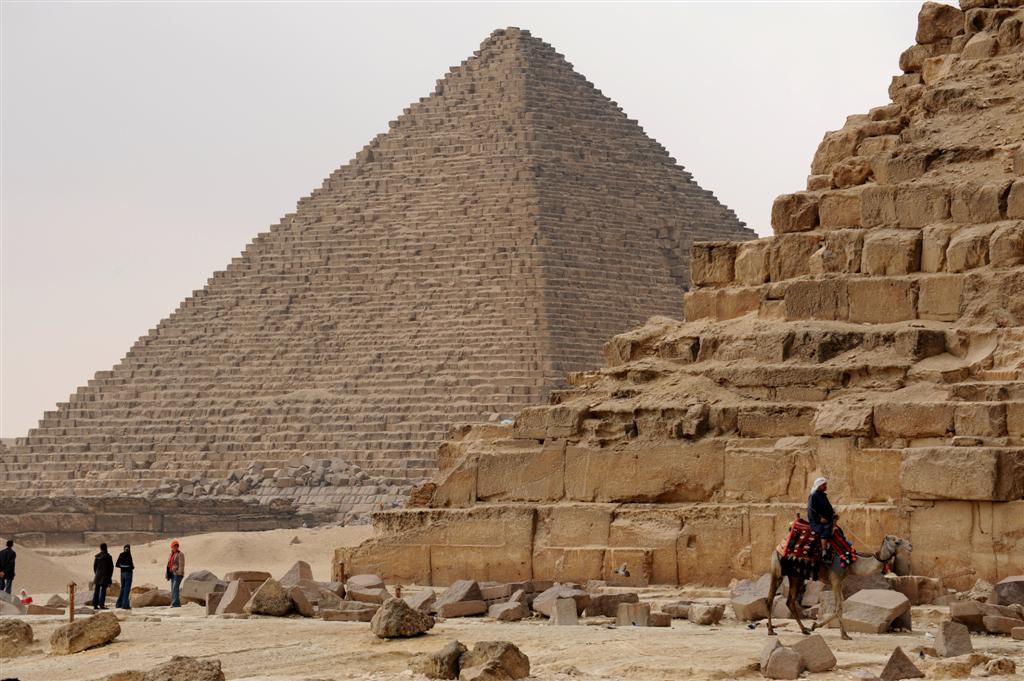
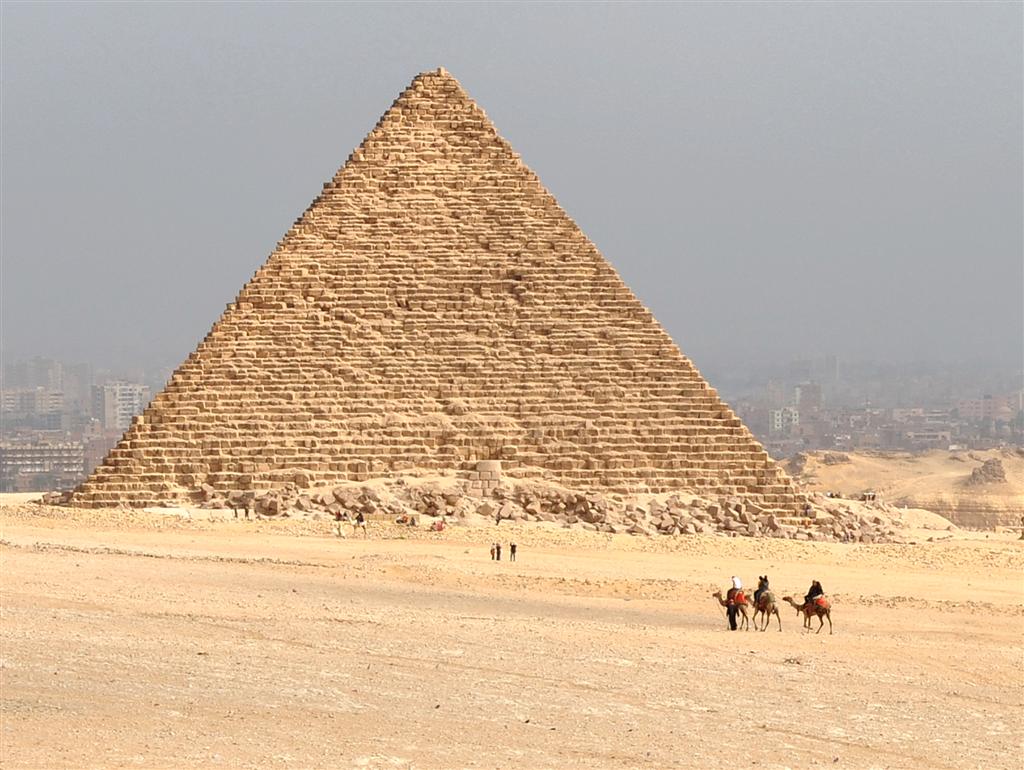
Camel and Pyramid Corner Overlooking The Small Pyramid Pyramid of Menkaure
We made it back to the bus not in 45 minutes but in 1 1/2 hours as there was too much to take in. From the bus it was a two minute drive up the road to the dramatic panoramic viewing area of all three pyramids. This was very definitely a KODAK MOMENT kind of place! From here we observed how antiquity and modern hustling/bustling urban Cairo virtually intersected, the latter encroaching almost right into the archaeological site. The juxtaposition was astonishing; providing a kind of ‘time compression’. After a good visit here we decided that we would return for our last half day in Cairo.
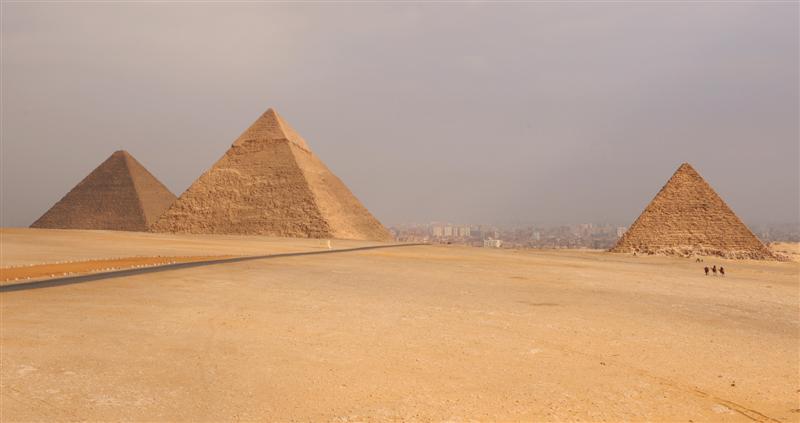
The Great Pyramids Of Giza On a Hazy Day Looking Towards Cairo
Of course no visit to Cairo can be considered complete without seeing the Great Sphinx! It is a dramatic view -- the Sphinx in the foreground framed by the three Pyramids behind. Many people’s first impression is that it is much smaller than imagined. Nevertheless, it is a grand sight… though standing only 65 feet high by 20 feet wide by 241 feet long – which in fact makes the Great Sphinx the largest monolith statue in the world. It’s exact date of construction is not known, but the common believe is that it was built around 2500 BCE. Access to the Sphinx is via a walkway which offers a gradual approach facilitating viewing and photographing the structure from different vantage points. Besides the ‘normal’ photos, we staged the obligatory ‘kissing the Sphinx’ shot. After this incredible morning we repaired to the sumptuous lunch buffet at Le Meridian Pyramids Hotel (which we highly recommend). I would recommend about twenty to thirty minutes at the Great Sphinx as sufficient to view and photograph this icon.
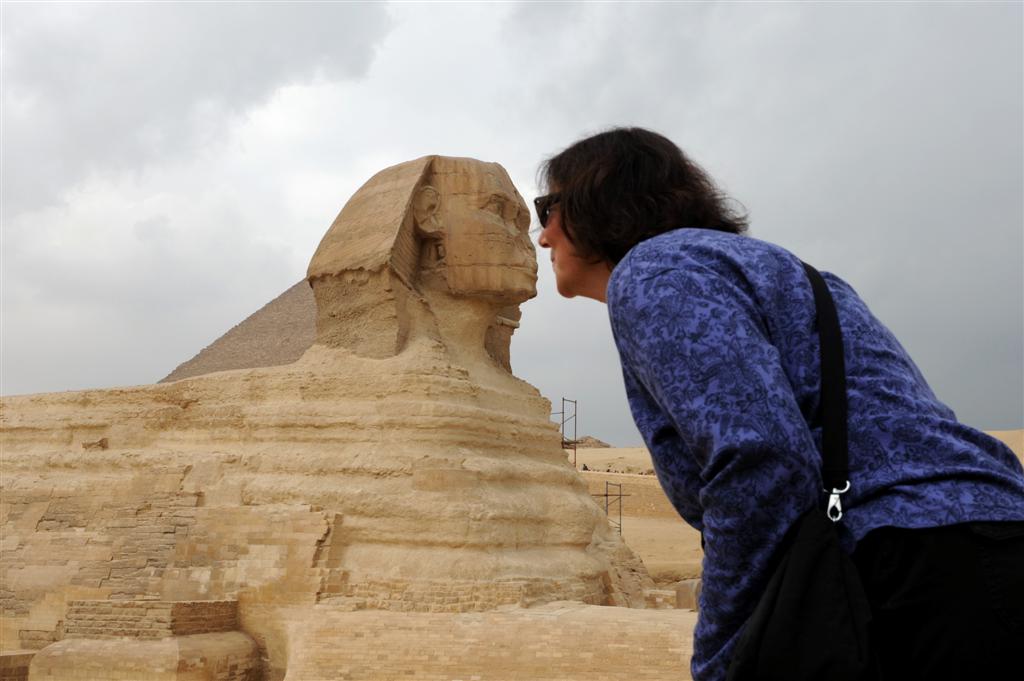
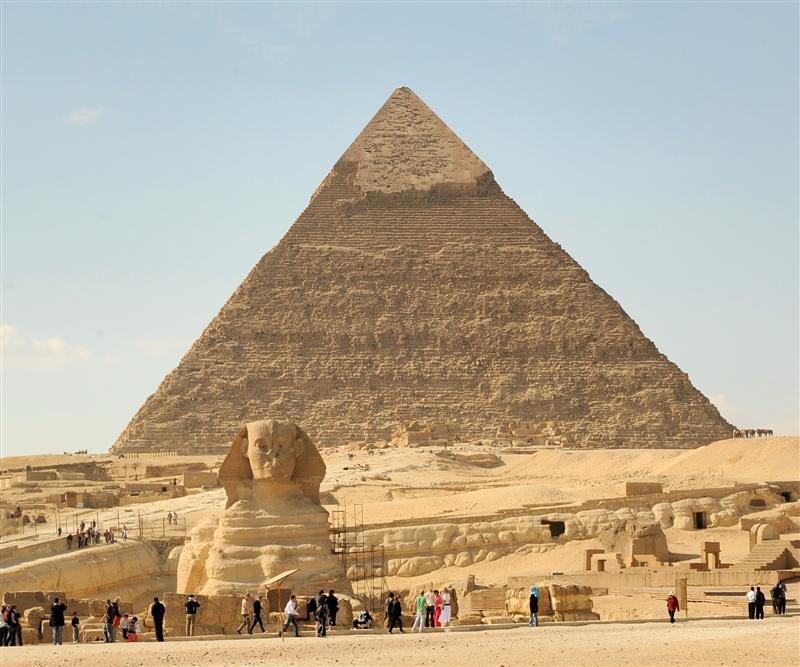
Kissing the Great Sphinx Great Sphinx with Pyramid of Khafre (the middle Pyramid)
Our plan for the rest of the afternoon was to visit the Khan El-Khalili -- better known as the Cairo Souk (marketplace). This market has been in existence at least since 1382. The section we were most interested in offered primarily souvenir items such as perfume, t-shirts, water pipes, spices, carpets, jewelry and a billion other trinkets. The Mom’s in our group indulged in a custom- made 18K gold cartouche. A cartouche is an oval plaque with hieroglyphics on it. Each lady had the first letter in their name translated into a symbol from the ancient writings. The ladies also observed their cartouches being made. This is certainly a uniquely Egyptian piece of jewelry to remember the Cairo visit! As with any bazaar blitz, bargain hard but be sure to decide in advance the maximum you will pay before you start. It is said that bargaining is expected and part of the local culture – so do bargain without guilt! Also, as always -- buyer-beware on quality.
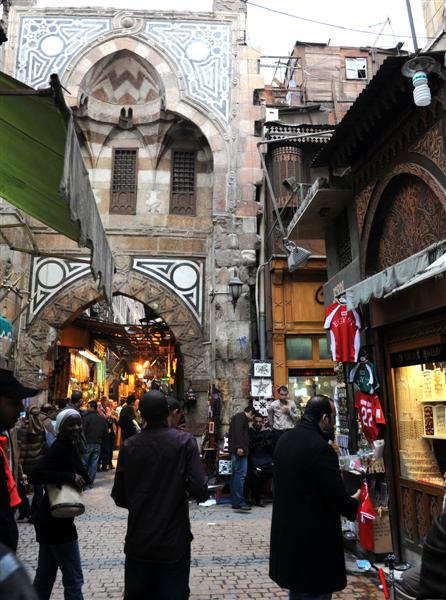
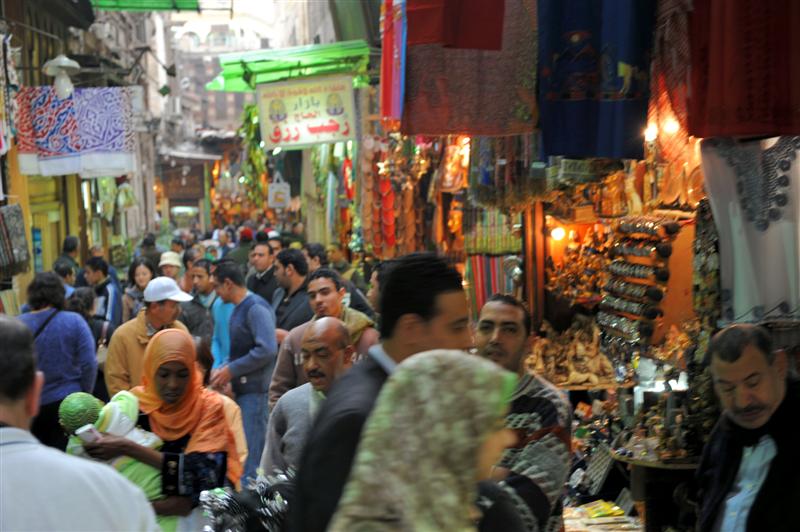
Cairo Souk
Dinner that night was at a local restaurant 5 minutes by taxi from in the affluent suburb of Heliopolis. We ate like the locals enjoying grilled lamb, shwarma, soup and a vegetable dish which we found reasonably priced and tasty. After dinner the adults and young-adult kids headed in different directions. We strolled past the President’s Palace to Corbo Street, where Thursday nights is the time to shop and be seen. (Whatever strife might have been going on in different parts of this region were not at all in evidence on Corbo Street that night!) Our kids had an enjoyable evening as well; they got to meet locals their own age. Our guide Amani had asked her 19- year old son to take our five kids to his favorite shawarma hangout. This was great way for young people to exchange ideas and culture and we were pleased the kids had that opportunity. After indulging in a tasty shwarma the two young ladies returned to the hotel, while the boys ventured forth to a café to try a hookah-shisha. A hookah is a water pipe where variously flavored tobacco is placed on the top and covered with aluminum foil and then topped with a few coals. Hookah smoking does not involve inhaling, but rather smokes like a pipe or cigar wherein you ‘taste’ rather than ‘inhale’ the fruited tobacco. (Now the P.C. disclaimer: While we as parents do not endorse smoking by our kids - nor do our kids smoke - we had no problem with them diving into the local culture for a night as it is an experience they will remember and take away with.)
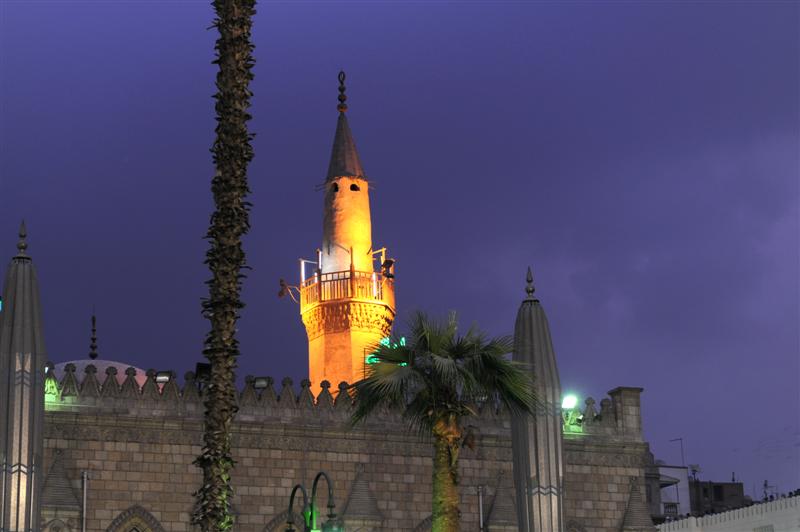
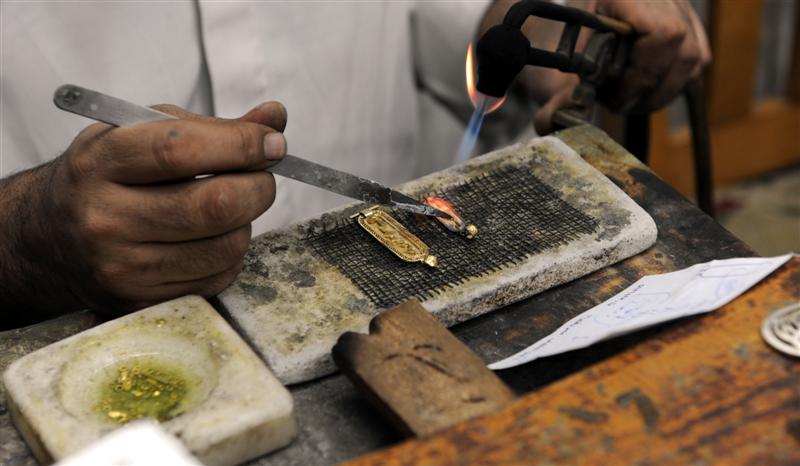
Minaret Outside of the Cairo Souk 18K Gold Cartouches Custom Made Using Hieroglyphic Letters
Off To The Upper Nile
Our kick-off for Day Three started with a 4:30AM hotel lobby assembly in order to catch our 6AM flight to Aswan. Our box-breakfast was eaten on the ten minute drive to the airport; fortunately at that hour there was no traffic. We met our ‘fixer’ Hossein and our guide Amani on the bus. Hossein worked his magic to board our baggage and secure our boarding passes without us having to deal with it. Also, while the airport is well protected on the outside we went through minimum security to get on the plane. Profiling worked to our benefit in this instance. We did not have to take our shoes off and could leave computers in the bag. While nearly everyone beeped going through metal detector at our gate, people at 5:15AM did not feel threatened by a plane load of only sleepy tourists.
We flew an Egypt Air Boeing 737 to Aswan with a 40-minute layover in Luxor. The seats were more comfortable and the aircraft was in better condition than the Delta Airlines flight to Cairo! Upon landing our Aswan fixer caught up to us, dealing with baggage and porters and getting our box lunches on the bus for our long ride to Abu Simbel later that day.
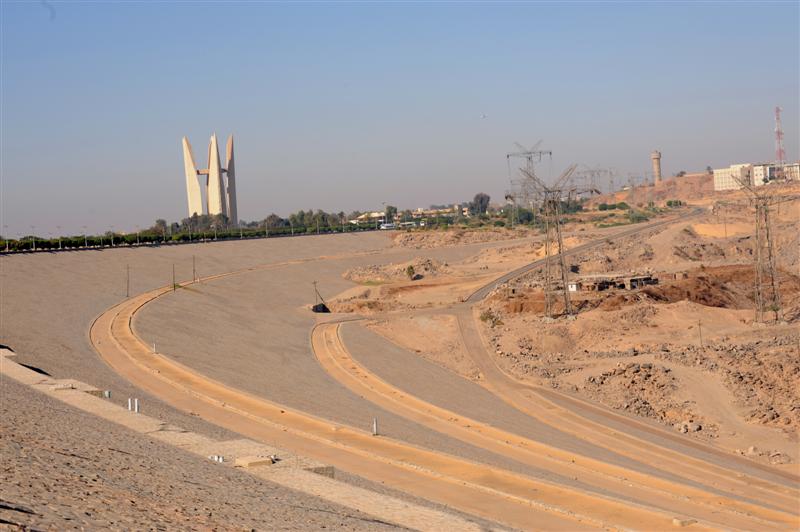
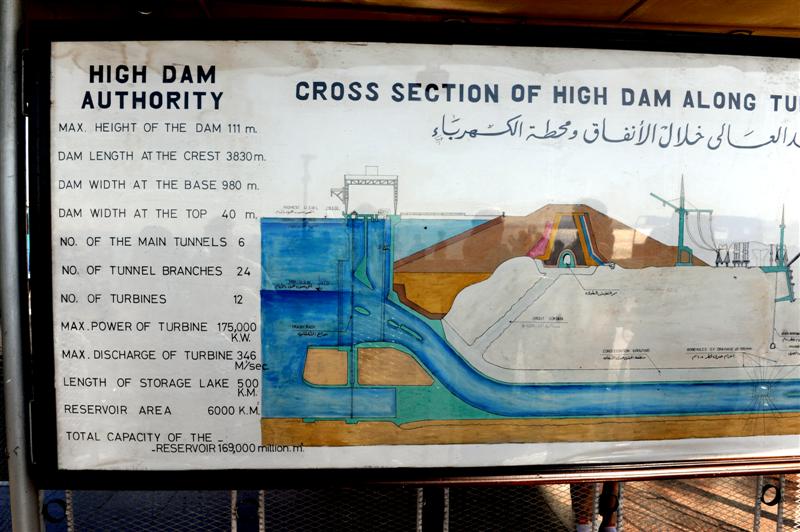
Aswan Dam
Our first stop in Aswan was the Aswan Dam. This is a great source of pride for Egypt as it produces much of the electricity for the country as well as regulates the floods that have troubled the region for millenniums. The down side is that without the annual flooding the fields do not have the natural nutrients replenished and need to use artificial fertilizers. The upside is that multiple crops can be planted year round due to constant irrigation coming from the river. If you want to see an impressive looking dam with working generators, go to the Hoover or Glen Canyon Dam in the Western USA. The Aswan Dam’s best attribute is the view of Lake Nasser. Seeing this place will only take 10 minutes as there are no tours of the power facility.
Our first stop after landing was the Aswan Dam. Phase One was completed in 1960 (funded by the Russians to gain influence in the Middle East to counter American and British access to oil); and the dam was and remains a great source of national pride as a symbol of Egyptian modernity and industrialization -- as well as the major source of electricity and water for irrigation for the entire country. The dam regulates the Nile water level and eliminates yearly flooding which has plagued the region for millennia. The flipside of eliminating the flooding though is that the nutrient-rich silt derived from the fertile volcanic soil originating upstream in the Great East African Rift Valley is trapped on the upstream side of the dam, and clogs the reservoir known as Lake Nasser. This forces the use of artificial fertilizers below the Aswan dam. The upside is that multiple crops can be planted year round due to constant irrigation coming from the river. If you want to see an impressive looking dam with working generators, go to the Hoover or Glen Canyon Dam in the Western USA. The Aswan Dam’s best attribute is the view of Lake Nasser. Seeing this dam will only take 10 minutes as there are no tours of the power facility due to security concerns as well as lack of interest in giving them by the government
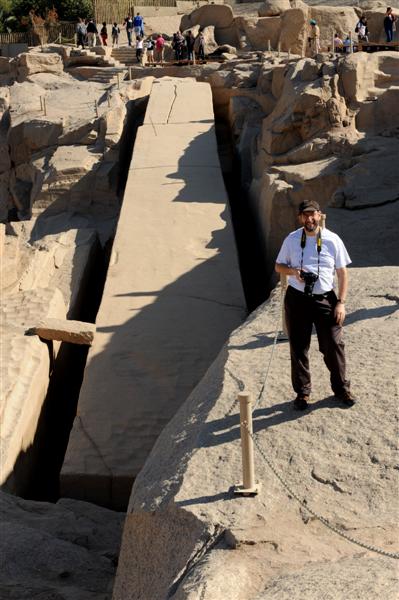
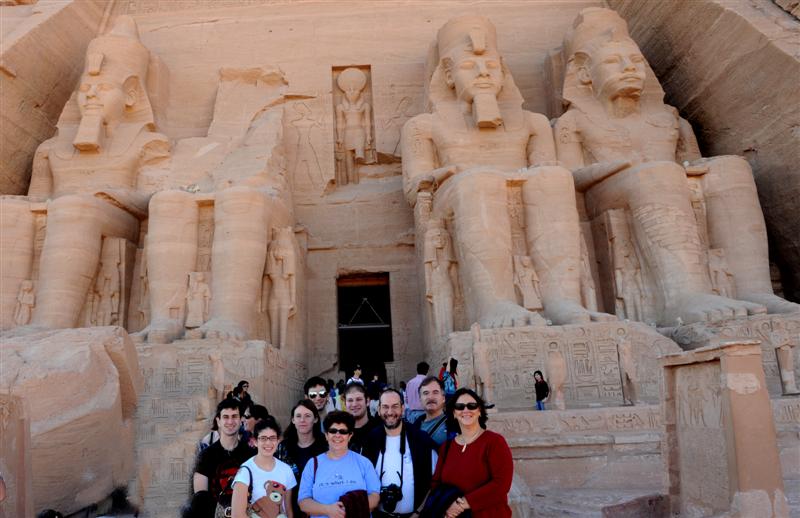
The Unfinished Obelisk Our Group In Front of Abu Simbel
After viewing Aswan Dam and the impressive and vast Lake Nasser, we proceeded to the Unfinished Obelisk. This ancient granite quarry contains the remains of what would have been the world’s largest obelisk, at 120 feet long and weighing in at over 1100 tons. During the cutting of the granite, cracks were discovered in the granite and the project was abandoned. It is interesting to see the unfinished obelisk with cutting in progress and seeing how and where it was chiseled down to the ground -- but then never cut out from its bottom. Thirty minutes for this site will dispatch it adequately. Exiting the place is encumbered by an army of aggressive shopkeepers before you reach the gate.
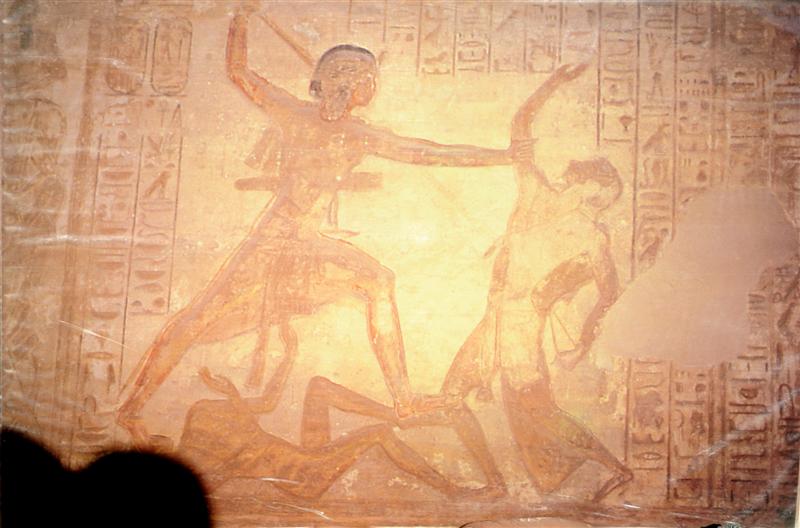
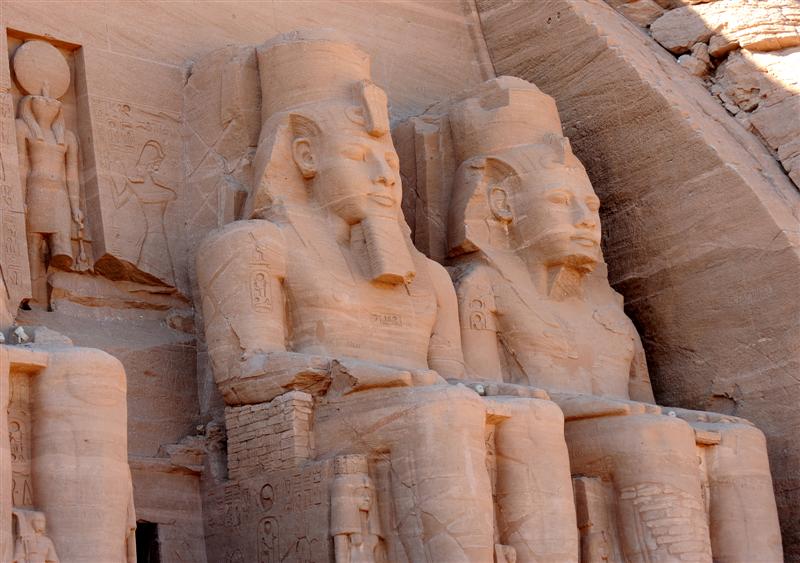
King Ramses II "smiting his enemies Abu Simbel Close Up
Next we settled in for a three hour drive across the desert to the stunning site of Abu Simbel which was the highlight of our day.. Many will remember the 1997 attack on tourists at Abu Simbel. To counter the threat of a recurrence, tour buses must assemble at Aswan, have their undercarriages checked with mirrors and then are convoyed together to Abu Simbel. Each bus has its own armed soldier with radio. This is a prudent precaution given that Abu Simbel is only twenty five miles north of the Sudanese border.
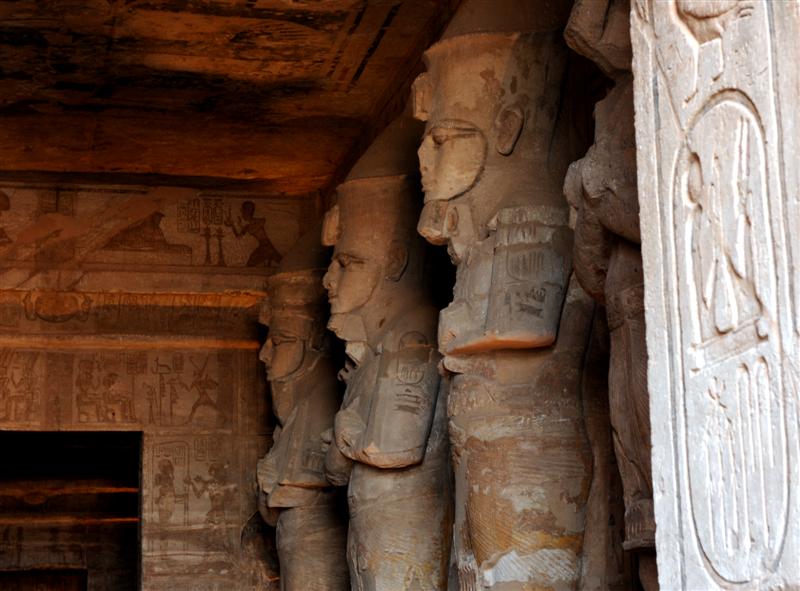
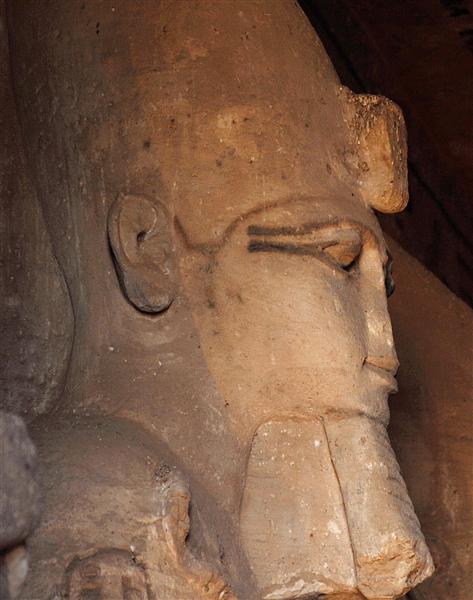
Note Details In First Chamber of Paintings and Carvings Eye Makeup Over 2000 Years Old!
Abu Simbel is a double dip masterpiece: this stunning complex was built in 13BC -- then disassembled and REBUILT in 1964 upstream -- to avoid being flooded by the rising waters of Lake Nasser due to the construction of the Aswan Dam! King Ramses II built two massive and complex monuments into the mountain; one for himself and another one for Queen Nefertari to honor an important victory. The other purpose was to intimidate the Nubians, who would have seen these majestic temples while traveling along the Nile River. The outside of the Abu Simbel Temple has imposing statuary 65 feet high at the entrance. Also at the front are various statues and large hieroglyphic figures, as well as a frieze of baboons known as the Sun Worshippers.
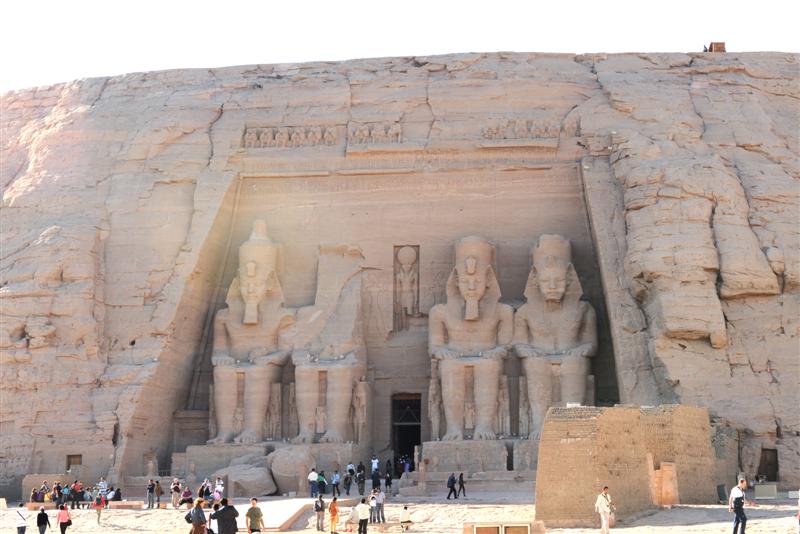
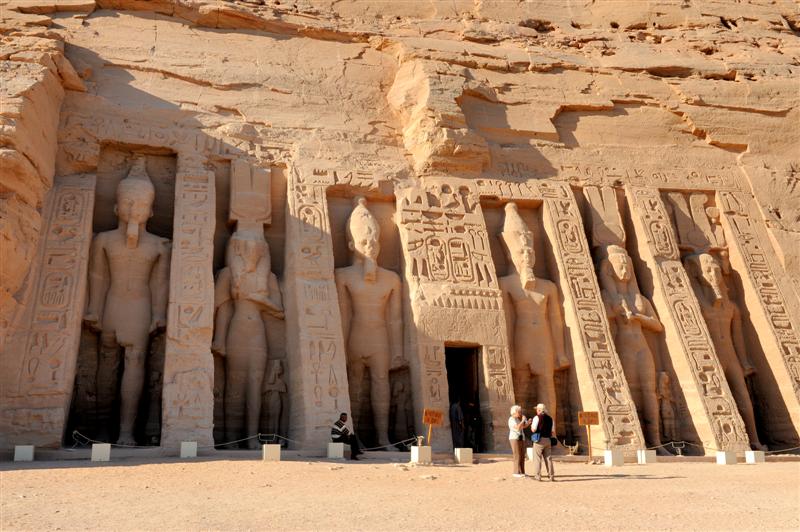
Kings Temple Queens Temple
The inner sanctum of the King’s temple is just as amazing as the anteroom which contains statues of the King. A series of rooms contain carvings and bas reliefs of the King and Queen in different situations. About 100 yards away from the King’s temple is the temple of Hathor and Nefertari ( known as the Small Temple). Abu Simbel is just too overwhelming with its depth of artistry and craftsmanship, and it is difficult if not impossible to convey the grandeur of the site in this writing. You just have to experience it. After walking through the temples we sat at a viewing location overlooking both temples. It is quite a journey to get to Abu Simbel and we all knew that we would not be back any time soon, so with about thirty minutes remaining before having to be on the bus, we returned to the King’s Temple to drink in the site one last time. On our bus ride back we watched the sky transition from deep blue to burnt orange just after the sun set, and then to a deep dark black owing to the absence of ambient light (and thus no light pollution). The heavens were just ablaze with stars; it was a sight to behold! If you go you go to Abu Simbel, it will be have to be via armed escorted bus tour. (The alternative is to take a 30-minute flight from Aswan, but bear in mind that you will have under two hours before the return flight -- and if the plane is delayed in arriving you will likely miss much of your ground time here.) Also, you should be aware that photography inside the Temple is forbidden and anyone caught taking a photo inside the temple will be asked to delete the pictures. Just buy the postcards at the shops.
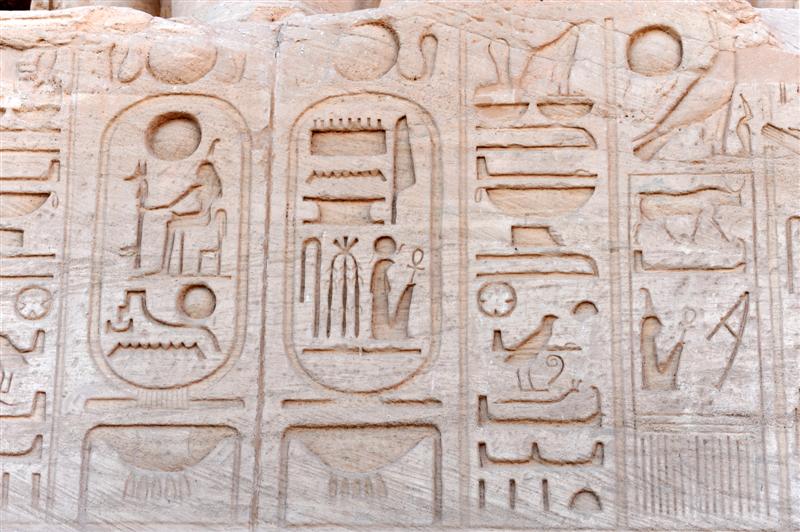
Hieroglyphics As If Carved Last Week! Channel 8 Aswan News 20 Minute Interview With Us Americans
After the long bus ride we were taken to our cruise boat run by Nile Quest for what was going to be a three-night cruise. This 62-cabin boat looked much like the other ten or so which were docked together in Aswan. After checking in we found the common areas and cabins to be comfortable. Our cabin was spacious and had a large window which could be opened, with another window by our bed which was fixed closed. Our three-night cruise basically plied the river for only a day and half. The boat actually left the dock late in the afternoon on the first full day and arrived at our first destination in darkness. The cruise itinerary calls for one night and two days in Aswan so that visitors can see the sites on arrival day, and then again the next morning until departure. We were supposed to arrive in Luxor late in the afternoon for the same reason – to tour the many historical and cultural sites in the vicinity of Luxor. After our dinner during our first night aboard ‘us parents’ were interviewed by a news crew from Aswan’s Channel 8 which was scheduled to be aired in February 2009. Evidently our guide Amani has many close ties to Egyptian ‘mover and shakers’, and the news station wanted to interview Americans. Questions during our interview ranged from what we thought of Egypt; to what we would tell people about our holiday; to what we would we like to bring back from Egypt; and what would items we wished we had brought with us to Egypt from New York. The interview involved about six questions and lasted about twenty minutes under the camera’s bright lights in the corner of the lounge. Our group were the only Americans amongst the 120 to 130 people on board.
.jpg)
%20(Medium).jpg)
Mausoleum of Aga Khan. A Large Herd of Camels Resting by The Nile
Views From The Nile River To Nubian Village Up River From Aswan
.jpg)
.jpg)
Nubian House at Edge Of Village Small Boat With Group In The Natural Park Area
The next morning we departed on a small outboard motor boat for our first excursion, proceeding upriver towards the Aswan dam to visit a Nubian village and other sites on the Nile river in this area. The Nubian people inhabited the area since ancient times and many were displaced when the dam was constructed. Enroute to the Nubian village we passed the Tombs of the Nobles. We witnessed a magnificent herd of camels resting on the riverbank, and a large imposing castle-like structure called the Mausoleum of Aga Khan. Our motorboat continued through some shallow areas at the first cataract around some small islands in a nature preserve. Just magic !
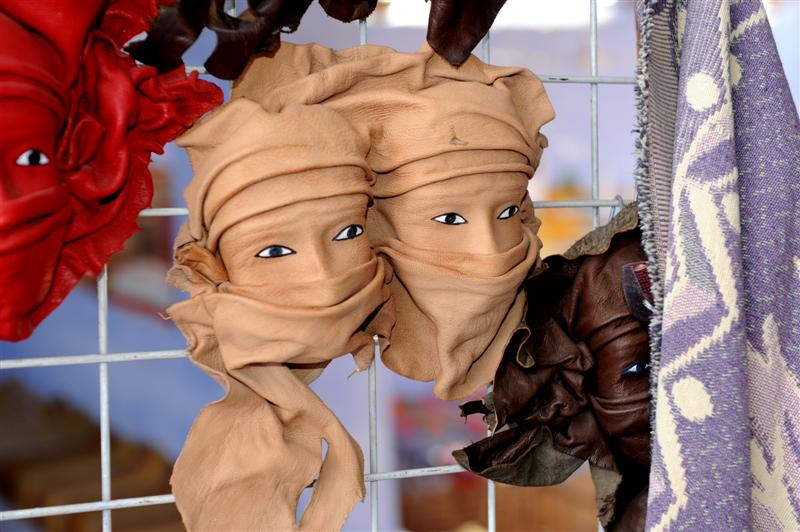
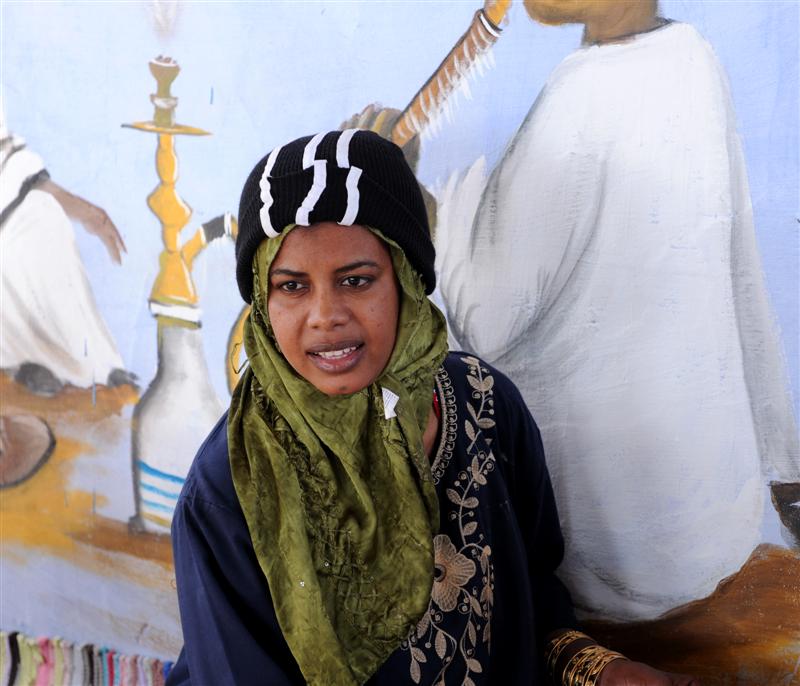
Scenes From The Nubian Village Include Ceramic Art, A Nubian Lady That Applied Henna Tattoos, The School Court Yard & Spices On The Street
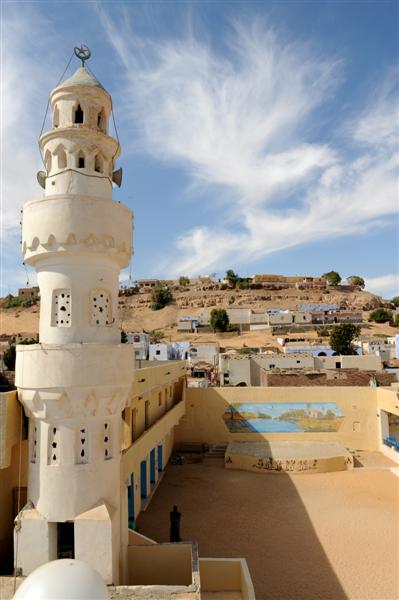
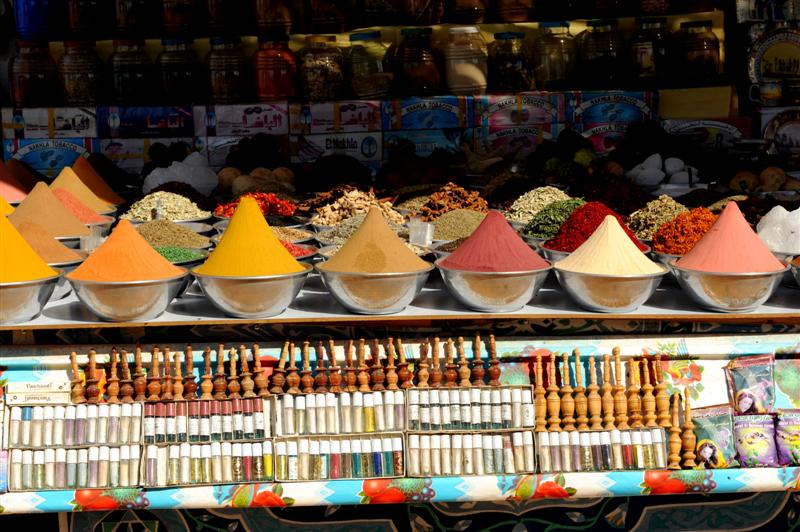
We enjoyed strolling around the Nubian village buying spices, scarves and hibiscus tea. We munched on some snacks of halawa (which we call halva ). We were also served some spicy cheese with fresh bread, and had memorably delicious mint and hibiscus tea served by a Nubian family. A young Nubian lady painted a henna tattoo on one of the girls, and on me! (I generally disdain tattoos, but thought that in this instance it would be fun to have one for our three week vacation. My tattoo depicted the sun rising over the river. I selected this theme because I love both being out in the sun, as well as being on the water). From here we strolled down the dirt street to the local school where saw the courtyard, some classrooms and also had a view of the dam from the roof of the schoolhouse.
On our return we motored by the eastern side of Elephantine Island where we caught glimpse of some ruins from temples dating back 2,500 years ago. We were also told it was the site of an important Jewish temple established 650BC. At the southern end of the island we passed an ancient Nilometer. The Nilometer was a vertical tunnel device that measured the height of the annual floods. If the meter read too high or too low no taxes were levied because the King and Queen would know that the crops would not be good that season. Frequently during our mini-cruise we passed picturesque felucca sailboats with their distinctive tall single sail catching the wind. When we arrived at Aswan we passed the Cataract Hotel, where Agatha Christy wrote Death on The Nile.
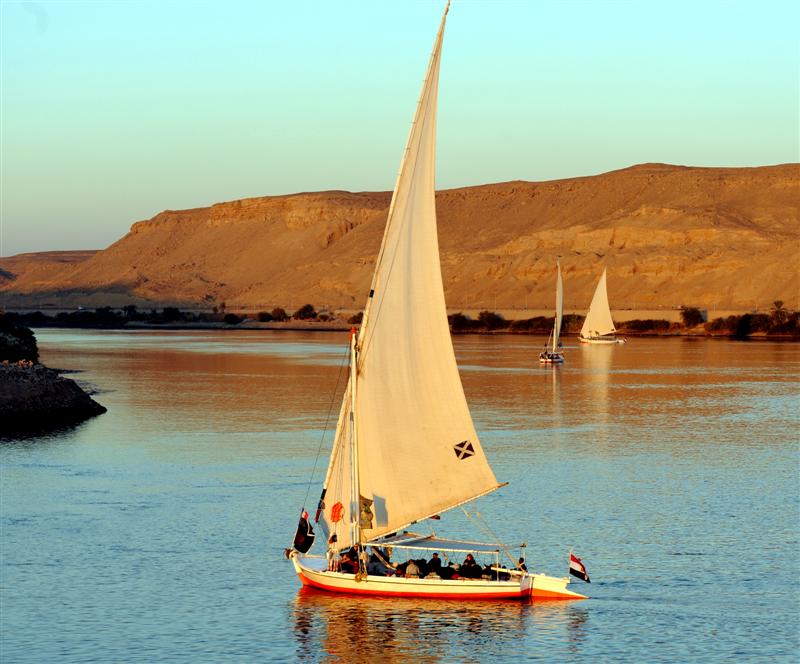
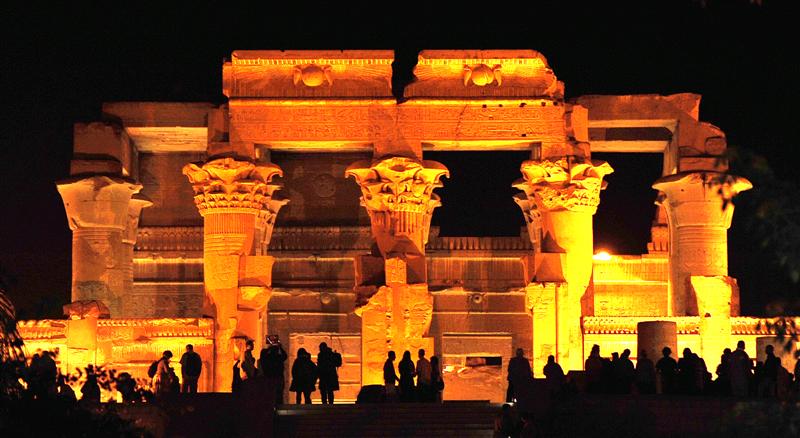
Feluca On Nile Once Under Way Temple Kom Ombo From Dock At Night
After lunch aboard our boat we were advised that we had about an hour before departure. Maureen and I decided to take a short walk along the river to stretch a bit. After walking about a hundred feet a man on a horse and carriage convinced us to take a thirty minute ride. We asked him to take us to a place to pick up some Egyptian wine and beer. We also needed a socket for the electrical devices we had brought. He happily took us through the streets to an unnamed warehouse where we were able to secure spirits, and then to the “electronics” part of town. (Keep in mind we had to be back in 40 minutes so this was a bit rushed; and in the back of my mind was the concern that we were being “taken for a ride”. We agreed to a fare of forty Egyptian pounds. My concern was that it might be ANOTHER forty pounds to RETURN. After purchasing our Egyptian wine and beer, our driver continued and stopped the carriage on a small side street in front of a store; Maureen decided to stay on the carriage. The store keeper told the driver and I to walk 50 feet on the smaller side street to get what we wanted. During our transaction a truck coming the opposite way beeped its horn and signed Maureen to move the horse ! She thought about it, touched the reins, saw a small motorcycle on the side and thought about moving the horse for about a split-second-- before giving a sign to the lads in the truck that she and the horse “ain’t movin’”. Luckily we returned in two minutes and realized that whilst in Egypt, waiting in traffic jams is not unusual! We frequently heard while in Aswan from locals that “We are friendly here, not like in Cairo!”. Indeed, our experience was that we found folks in Aswan to be less “pressurizing”, and in fact honest in their dealings with us. For example, when I misunderstood the payment for a purchase, I was recalled to retrieve two Egyptian pounds as my change ($.36). Please be advised that it is not good practice in the Cairo shuks to hand over large paper bills to the merchant for payment, because the seller is apt to suddenly and mysteriously run “out of change”- obliging you to accept some additional (and not necessarily wanted) merchandise instead of your change.
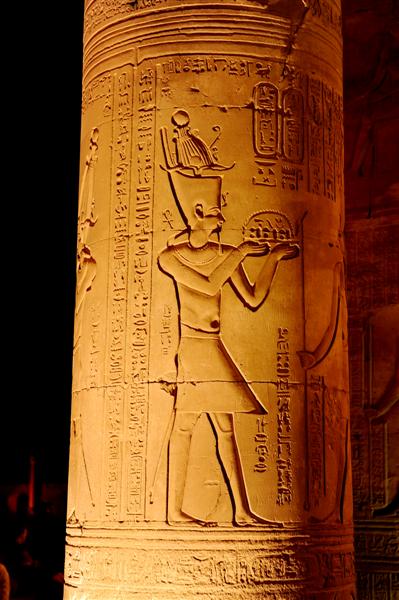
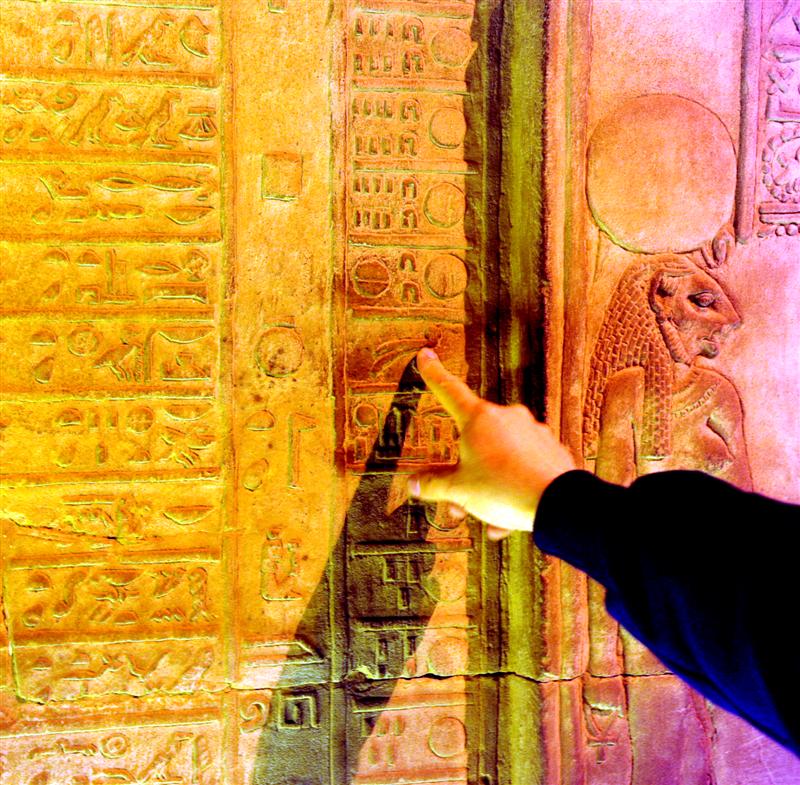
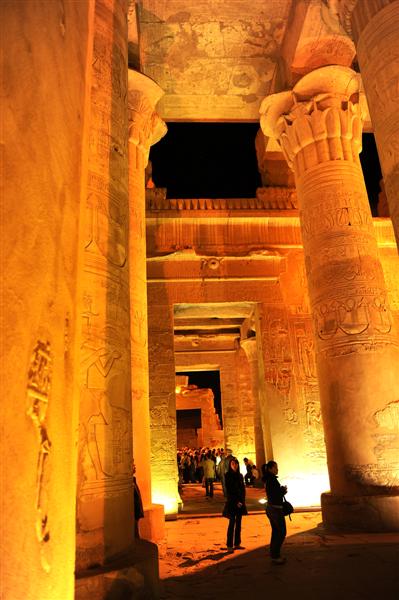
Pillar With Preserved carvings An Early Lunar Calendar Kom Ombo
Our ship got underway at 3:30 and at 4:30 it was high tea with the kids on the top deck with the sun setting about an hour later. At 7:00 we arrived at Temple of Kom Ombo and tied up to 3 other cruise boats which were alongside another 20 or so. The temple while crowded was manageable. Our guide told us about the highlights and took us through the place quickly. She also said to wait about an hour to get close to these highlights as the crowds will diminish then. We were also reminded be back at the boat by 8:30. Construction on the Temple of Kom Ombo’s began in 180 BC, with a big addition added in 47BC. It was dedicated to Sobak (the crocodile god) as well as Horus (the falcon god). The temple is known as ‘the crocodile temple’ because of the mummified crocodiles here. In fact this site was actually two temples with duplicate areas when it was finally completed.
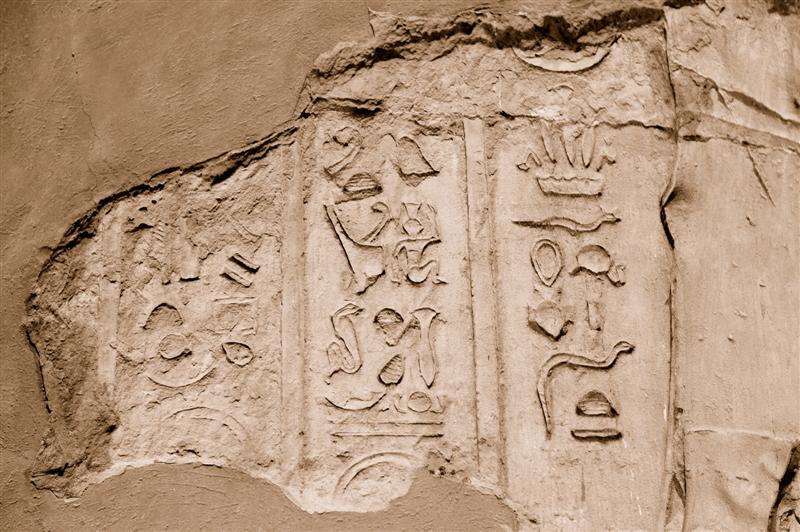
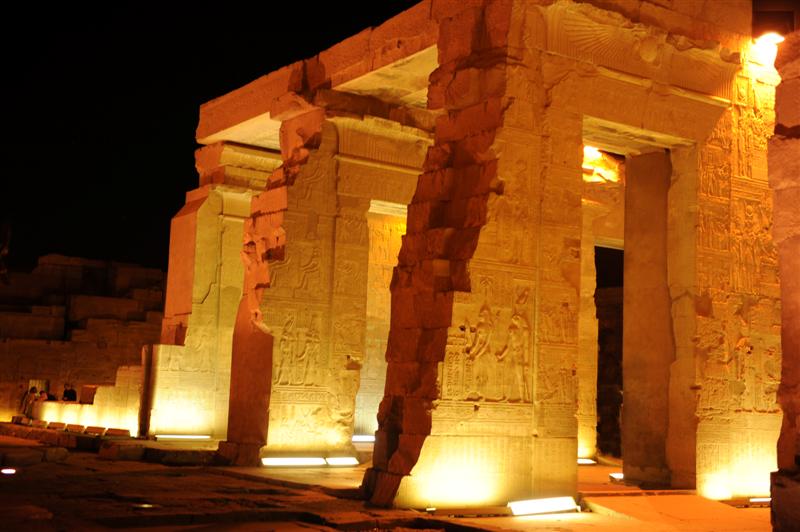
Hieroglyphics
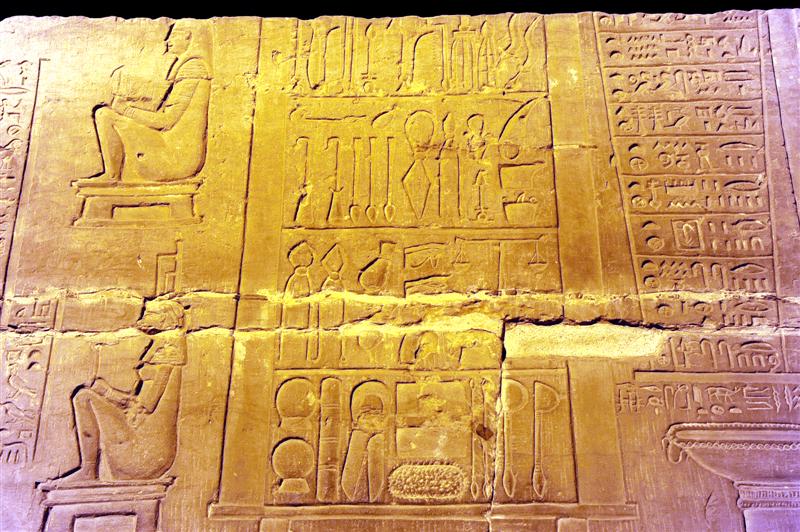
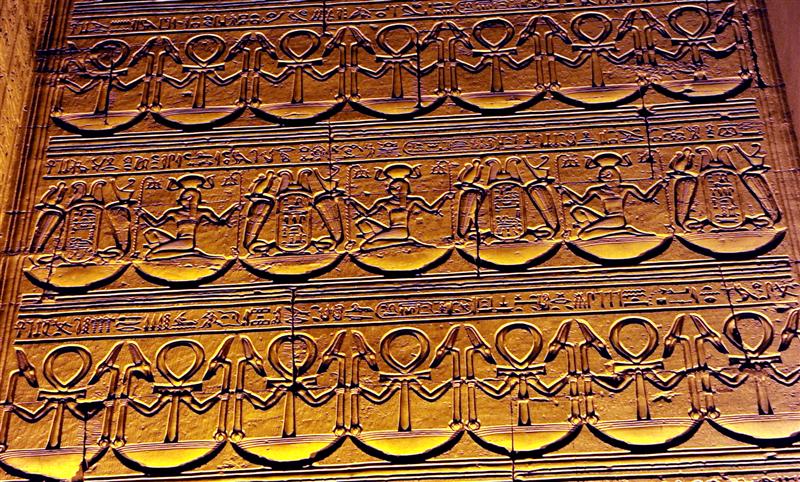
Photos Showing Ancient Medical Instruments At Kom Ombo Amazing Details Telling Stories Over 2200 Years Old
We found Temple of Kom Ombo to be another amazing place to visit made special by being there at night all lit up. It had magnificent columns, different rooms, a nilometer, plenty of well preserved hieroglyphics and lots of carvings of different scenes from the times. Highlights included relief's of Queen Cleopatra II and III, the first lunar calendar carved into one of the room’s walls. It also had carvings showing the different medical instruments used at the time. Some of the carvings and reliefs are so well preserved that you can still see the color on them. In one of the last rooms we visited we saw two mummified Nile crocodiles protected by glass cabinets. I would say the 90 minutes we were given was plenty of time. If you go at night, enjoy the outside and large rooms first. This way the crowds will be gone from the popular areas in the tighter spaces inside. Also, remember where the boat is docked and not what boat you were tied next to because the inner boats do move as had happened to us.
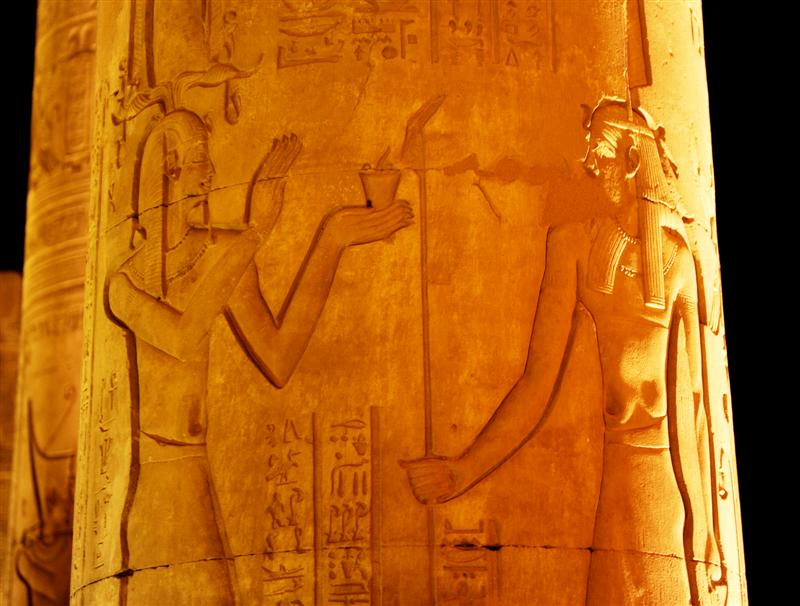
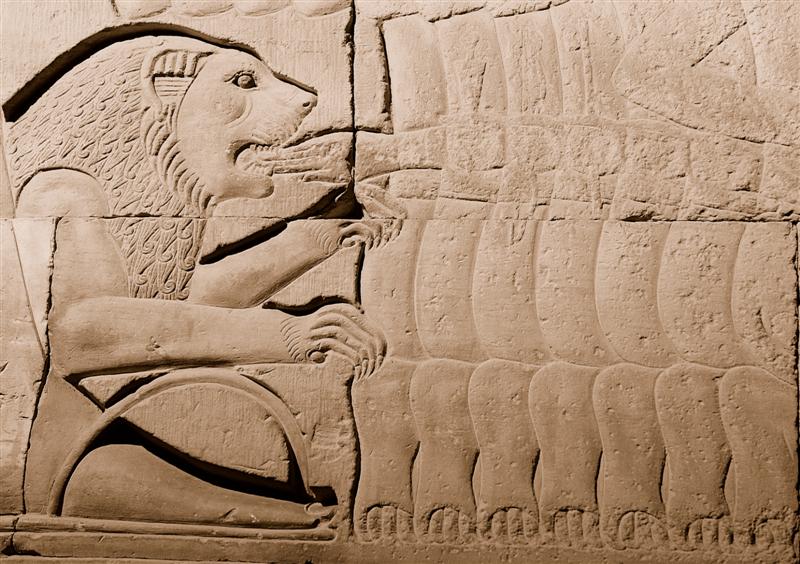
"Ancient Beverage Service?" Feeding Slaves Hands To The Lions
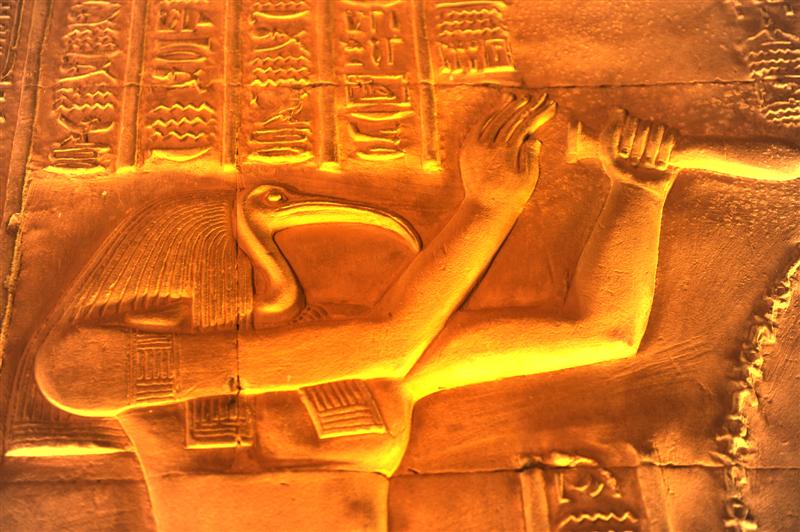
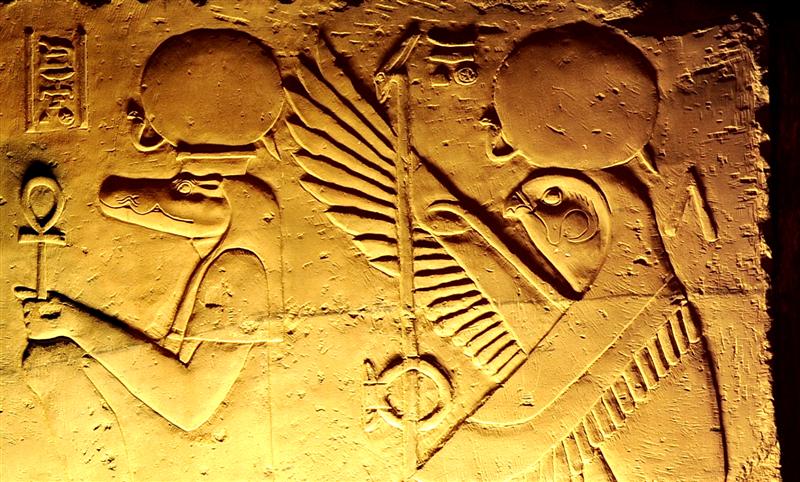
Egyptian Gods (Not the well preserved details!)
We all thoroughly enjoyed our visit to the Temple of Kom Ombo ,which we considered to be yet another amazing site to behold. The night lighting was truly dramatic and invoked the majesty and mystery of antiquity ! What a spectacle with magnificent columns, interlocking and fascinating rooms, a Nilometer, many amazingly well-preserved hieroglyphics and an unending panoply of engravings and carvings depicting the live and times of antiquity. Highlights included reliefs of Queen Cleopatra II and III, and the first lunar calendar carved into one of the room’s walls. It also had engravings depicting the medical instruments used at the time. In fact, some of the carvings and reliefs are so well preserved that one can still discern color on them ! In one of the last rooms we toured we observed two mummified Nile crocodiles protected by glass cabinets. We were allotted about ninety minutes to view the site and that was about right. If you should be fortunate to visit at night, my recommendation would be to enjoy the site from the outside first, giving time for the crowds inside to dissipate so that you will able to get closer to the interior highlights. Also, remember where your boat is docked (and not what boat you were tied next to, because the inner boats do depart, leaving some perplexed tourists wondering which boat they are supposed to board as had happened to us)
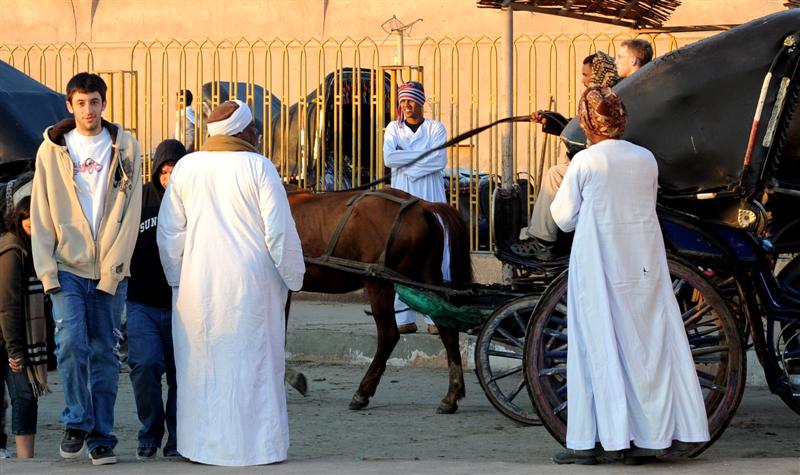
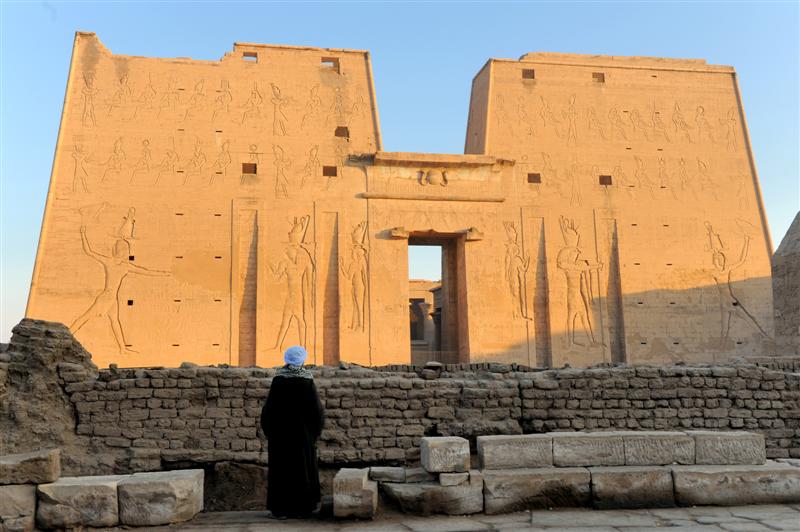
Dan Making Way Past Carriages at Temple Edfu Main Gate / Door at Temple Edfu
The next morning we needed to be “up and at ‘em” by 6:30AM. Each family unit was assigned a horse-drawn carriage and spirited off to the Temple of Edfu. As these drivers are paid “per load”, our journey was a pretty quick ride through the streets until we arrived at the main gate just as it opened for the day. The Temple of Edfu was built between 237BC and 57 BC and was dedicated to the falcon god Horus. It is a tall structure which you can see once past the admission booth . The entrance features a tall wall with a large door, protected by statues and carvings. A courtyard opens up once past the entrance framed by many by columns. Beyond the court yard there are secretive rooms with an altar in the back of the site. The walls are adorned with many carvings and hieroglyphics. There is evidenced here -- as with at many ancient temples – where the Egyptian gods’ heads were destroyed by Christians.

The Main Alter Temple Edfu Perfectly Preserved Hieroglyphics
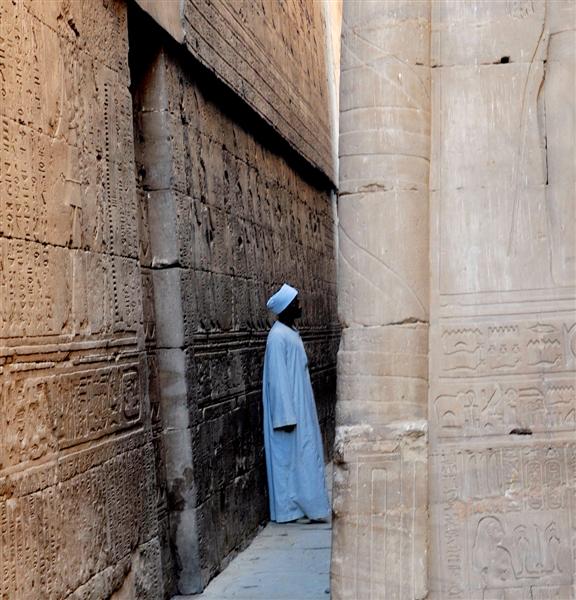
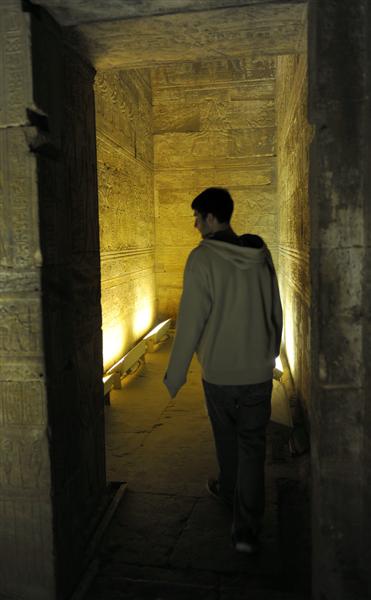
Quiet Corridors, Alleys and Rooms at Temple Edfu. (Note Carvings and Hieroglyphics Everywhere!)
It should be noted that the Temple of Edfu is one of the best examples of an ancient temple because it was preserved almost entirely in sand and silt until its recent discovery in 1860. At that time the sand and silt was removed, and restoration took place. After examining each room we headed to each side of the temple to observe the inner and outer walls.
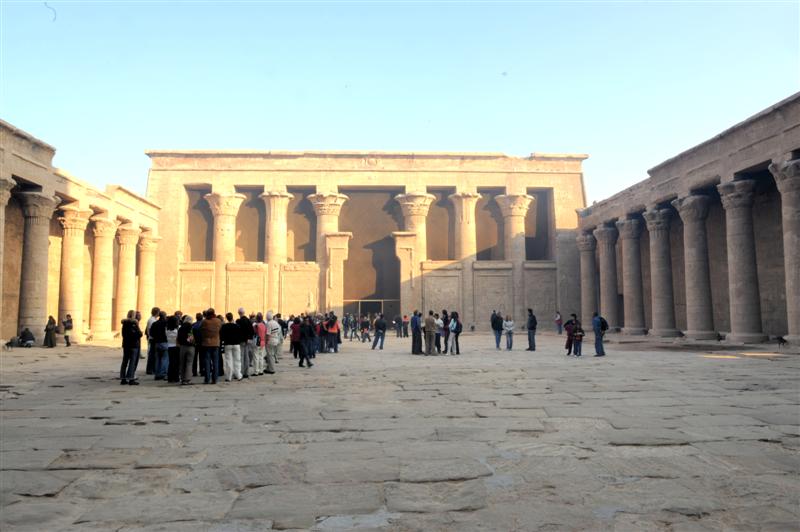
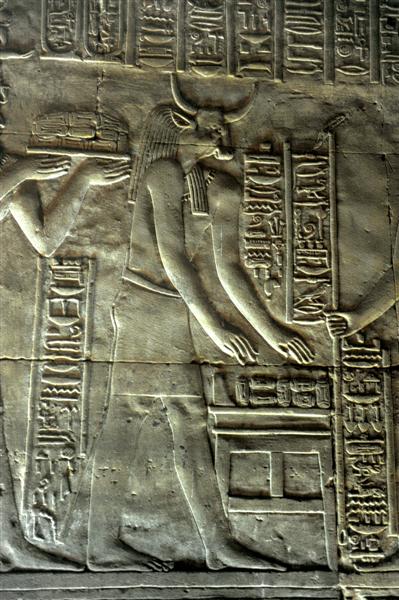
Main Courtyard Temple Edfu Egyptian Gods with the Ancient Writings
When we finished seeing this temple we exited to the side, and met several hundred of our “new best friends” (our fellow sojourners to Egyptian antiquity, who were either waiting for their carriage or tour bus to return them back to the cruise boats. The scene in this area where the carriages were all lined up was quite a colorful one, with men in local attire jockeying for position to get a fare in their carriage. Once my family was secured in a carriage, I had bit of fun on our ride back, because I took the reins and relieved our driver of his duties! In anticipation of baksheesh, the drivers offer their guests the carriage’s reins for a playful “photo opportunity” on the open road.. I guess our carriage driver got a little more than he bargained for when he gave me the reins – and I then declined to relinquish them ! He seemed mildly disenchanted with my indiscretion however, once I showed him I was able to maneuver around stopped cars, negotiate narrow narrow streets, execute passing moves around slower horses -- he “chilled”.
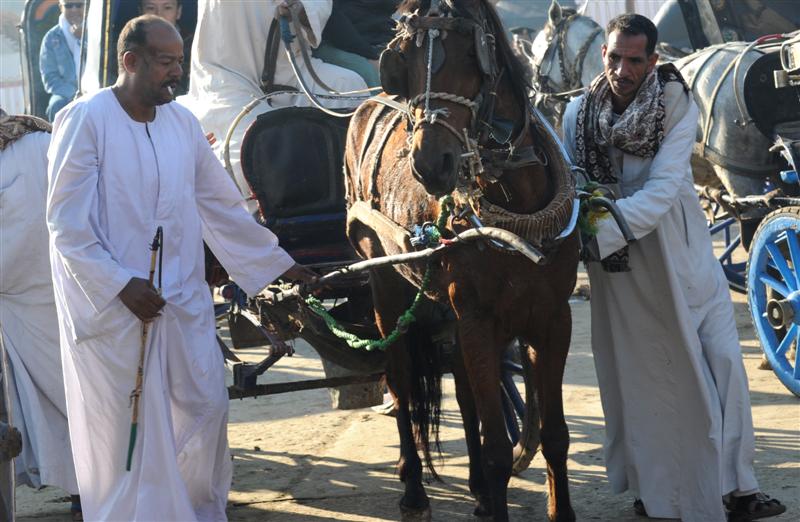
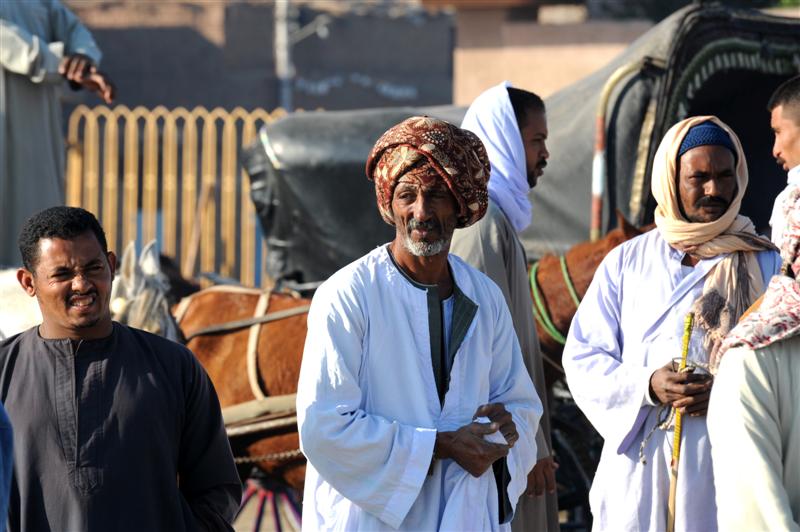
Edfu Carriage Driver in Local Attire
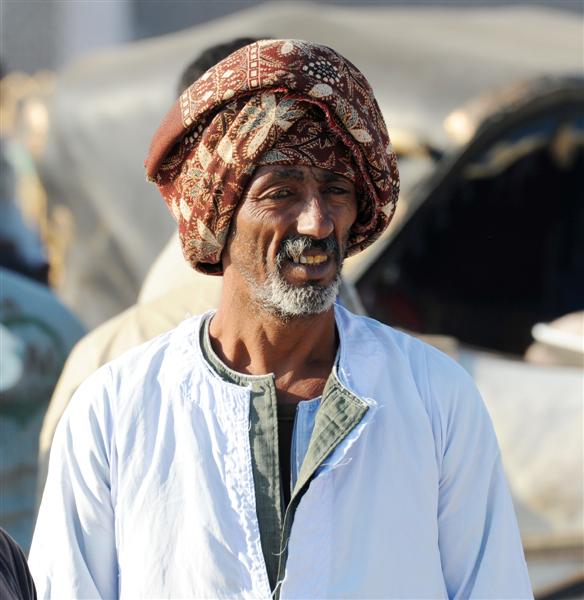
Street Scenes In Edfu Cairo. Center: "One In Hand" on way back from Temple. Right: Conservative Dress by the Coke Machine
We then reboarded, had breakfast and had a planned departure of 10:30AM. We were heading downriver to Luxor, and our cruise was to include a transit of Nile River locks. The plan was for this to be a full day of cruising, getting us to Luxor by 5:30PM with an early evening tour of the Luxor Temple. Unfortunately…”Man plans, God laughs…” We were on “manyana time” (as is typical of Egyptian ways and means), and our schedule sustained a forty-five minute late departure. This meant that we arrived at the locks late - and the crew claimed we had lost our spot in the queue. We suffered further delays by having to disembark a group of Greeks at the dock near the locks. Once at the locks, we were tied up to the other boats and had to wait over an hour for two other boats go though sequentially. Finally we were cleared to transit and the second set of locks were also opened up, allowing us to make up at least a little time. What happened next was interesting: An official boat pulled up and our crew tossed them a package of tea and a white bag. Given the Egyptian way of life of “baksheesh”, we speculated that the bag had cash to grease the skids for our boat to proceed.
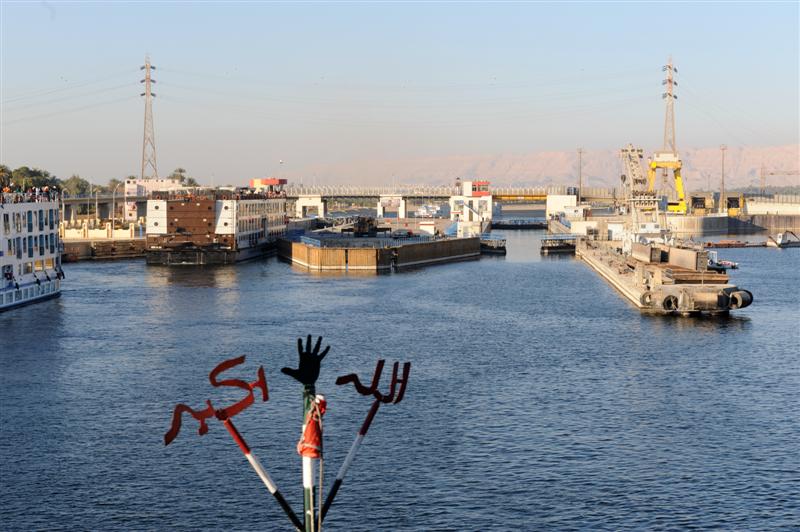
Approaching Locks On Nile Michael Ehrlich In Background With Captain Of Boat
When we approached the first open lock, our crew tossed over another white plastic bag to the dockworkers on the lock. This time we spotted them opening it up -- and guess what… we were right … we saw the cash. Nothing works in this country without cash, and I suspect this was no different! The lock crew guided our vessel through by taking our boat’s long lines, and walking them up from cleat to cleat, and keeping our boat straight while transiting under its own power and steering. After the transiting the first lock, we had to wait for the second one to clear. This second lock transferred two boats down about forty feet to the next (lower) level. Our final delay was due to shallow water forcing our captain to reduce speed to slow ‘impulse power’. Thus, with all the delays it was not written in the stars for us to arrive at Luxor in time to see the temple at night. Temple Luxor was added to our already busy schedule for the following day. We dined aboard then took a taxi to the local souk to browse for souvenirs. Being experienced souk-goers by this point, we enjoyed this souk experience thoroughly. Our group bought a few hand-painted papyrus scrolls, and another group returned with attractive hand-made inlaid boxes. One of the sheer joys of travel are those serendipitous unplanned encounters, and we were treated to one such encounter at the souk. We spotted and looked in on a small bakery, and in keeping with the culture of hospitality to sojourners of the region we were invited into the bakery to observe the inner workings, and of course then taste the flame roasted bread just as it exited the oven conveyer belt. The bread was delicious! Photos were taken and baksheesh was in this instance most gladly conveyed; and then it was back to the boat. (Incidentally, the taxi which whisked us back to the boat was a thirty-eight year old Peugeot wagon – who would have thought these French cars lasted this long ! The ride was about $3.)
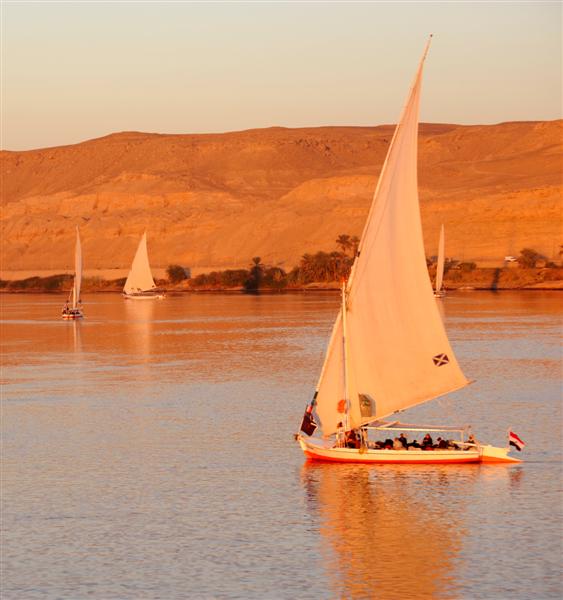
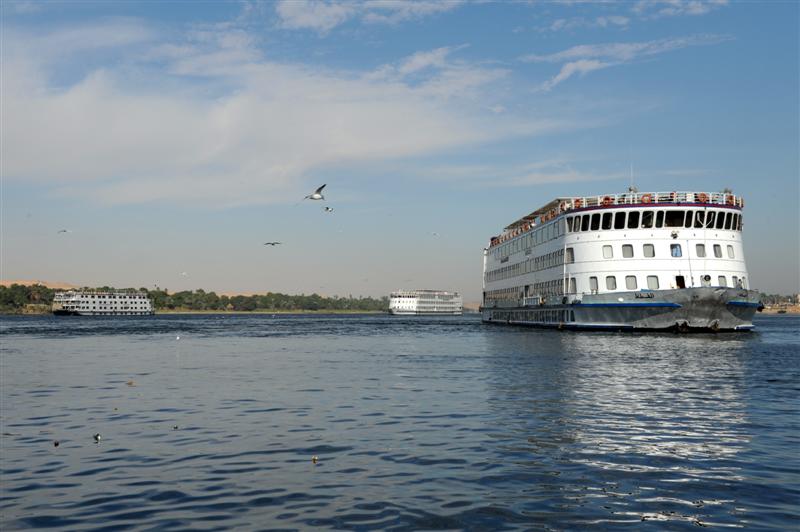
Felucca On The Nile At Dusk Cruise Boats On the Nile
Our last day in the Luxor area was going to be very hectic because we did not get to tour the Luxor Temple complex the previous day. Our goal was to see three of the tombs at the Valley of the Kings, THEN do a “photo-op stop” from the distance at the Mortuary Temple for Hatshepsut. We would then move on to Habu Temple, having lunch there. We would then RETURN to Luxor to spend a few hours at the magnificent Karnack Temple as our final visit of the day at Luxor Temple. (Temple Luxor is open for touring each day until 8PM). If this sounded like a lot to do in one day, it is because it was.
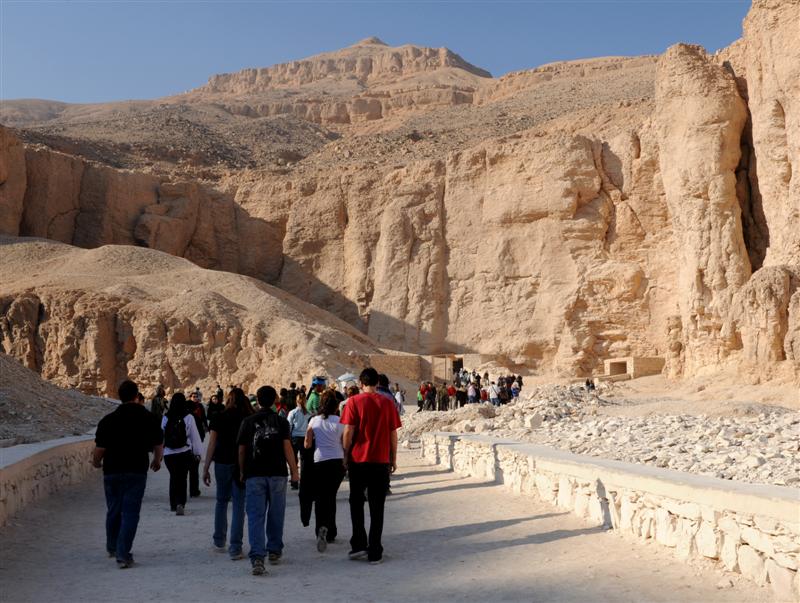
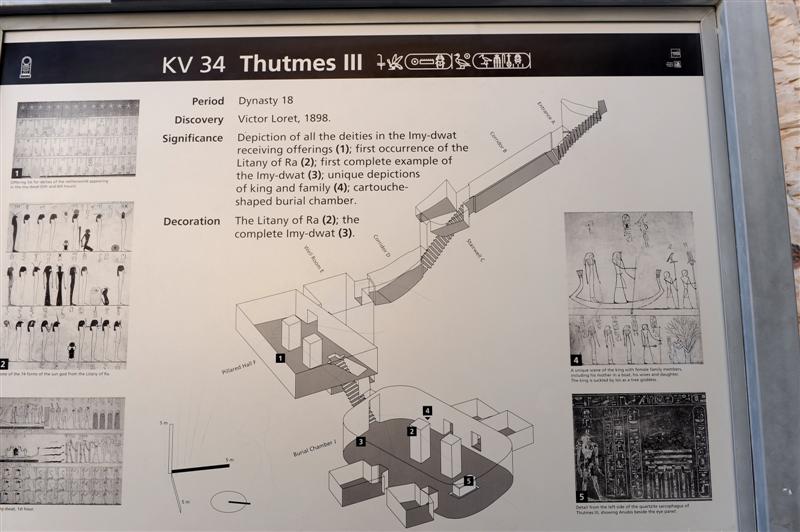
Walking Into The Valley Of the Kings Sign At Thutmes III Explaining The Burial Sight
The Valley of Kings is a very different experience than the other sites we had seen. The aforementioned temple complexes generally presented as majestically tall with pillars and statuary. The Valley of Kings seems purposefully and carefully integrated into the natural beauty of the surrounding valleys and hills. We entered the visitor center, got oriented to the site by examining a scale model, and then took a tram to start our tour of the tombs. The admission ticket provides access to three of the sixty three tombs in the site. It is possible to pay a supplement to tour additional tombs, and if we had more time we probably would have done exactly that. During the winter months different tombs are periodically closed for restoration. We visited the tombs of Thutmes III, Ramses I and Ramses IX. The details are amazingly well-preserved deep underground in this complex, which is the world’s most famous and expansive necropolis. Thutmes III had the most intricate of the tombs we visited. The cartouche shaped burial chamber was deep inside the mountain, and it was necessary to descent many stairs deep underground past two rooms, then dropping down a final set of stairs. There were 4 small chambers set off from this inner sanctum. The entire tomb site featured intricate carvings of Thutmes III’s family and various different gods. Ramses I had a simpler tomb cut into the mountain. Access was via a straight staircase descending underground and terminating into the final chamber traversing only one corridor. Decorations included Ramses I performing rituals, as well as Ramses I being accompanied by Horus and the god Anubus. There were many other religious scenes and other amazingly-well preserved carvings on the walls. The last tomb we visited was Ramses IX. Access was via a long pitched walk through six corridors which were the most elegantly colored of the three tombs we visited. After passing through the last corridor we entered the last chamber, where the burial took place in a large pit. (NOTE: a word of warning: Do NOT take photos here. You will be subject to expensive fines, and cameras will be confiscated until the fines are paid. Unlike other temples -- where baksheesh of a few pounds will make all manner of problems disappear – the rules are strictly enforced at this site).
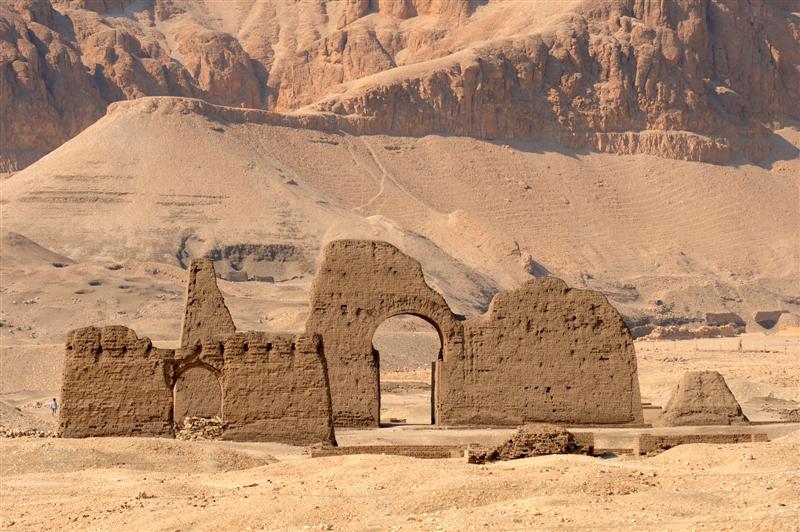
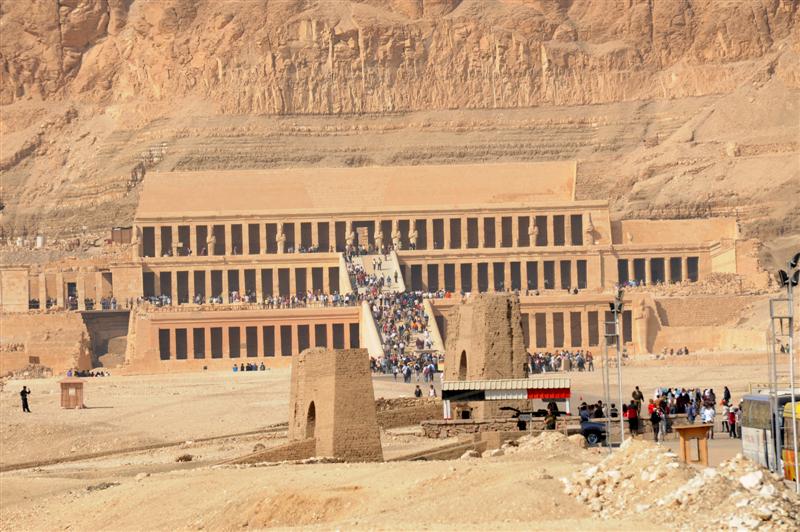
Ruins In Front of Hatshepsut Mortuary Temple Queen Hatshepsut
From the Valley of the Kings we did a quick photo stop at Mortuary Temple for Queen Hatshepsut. This is a place unfortunately we could not see because of the delay getting to Luxor the day before. After our photo stop we headed to the Habu Temple.
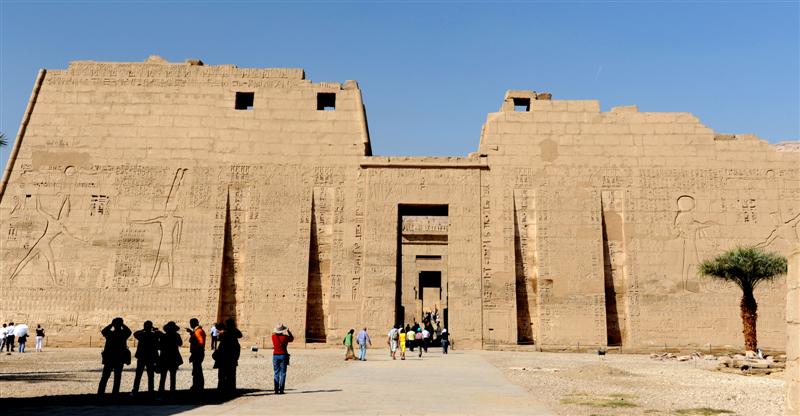
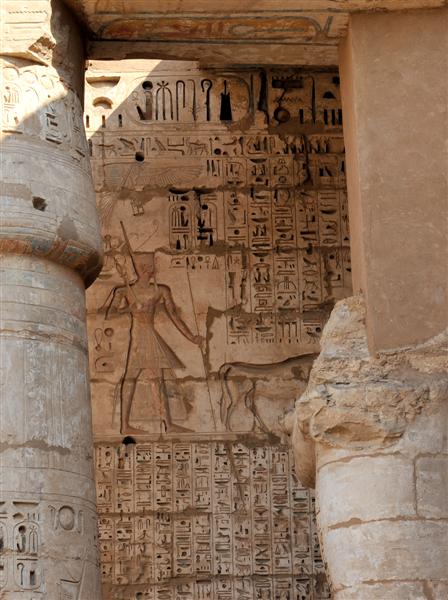
Outside Habu Farm Scene Between Pillars
Habu Temple is also known as the Mortuary Temple of Ramses III. It is 700 feet wide by 1000 feet long and is enclosed by fortified walls. Ramses III oversaw the construction of this fortified place of worship over the ruins of a former temple. It is a well-preserved site with 75,000 square feet of wall surface adorned with carvings and wall reliefs. Nearly every available part of wall, pillar or ceiling surface is covered! The details are astounding. Although some are not for the faint of heart; one wall depicts a pile of severed enemy hands, and another has severed male organs. (Warfare in those days was up close and personal!)
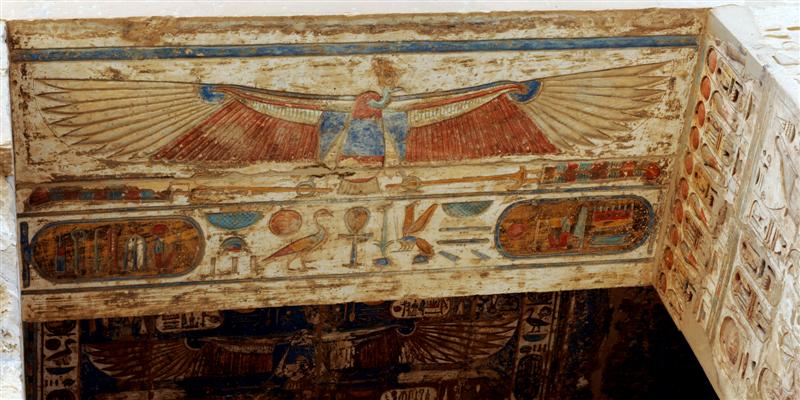
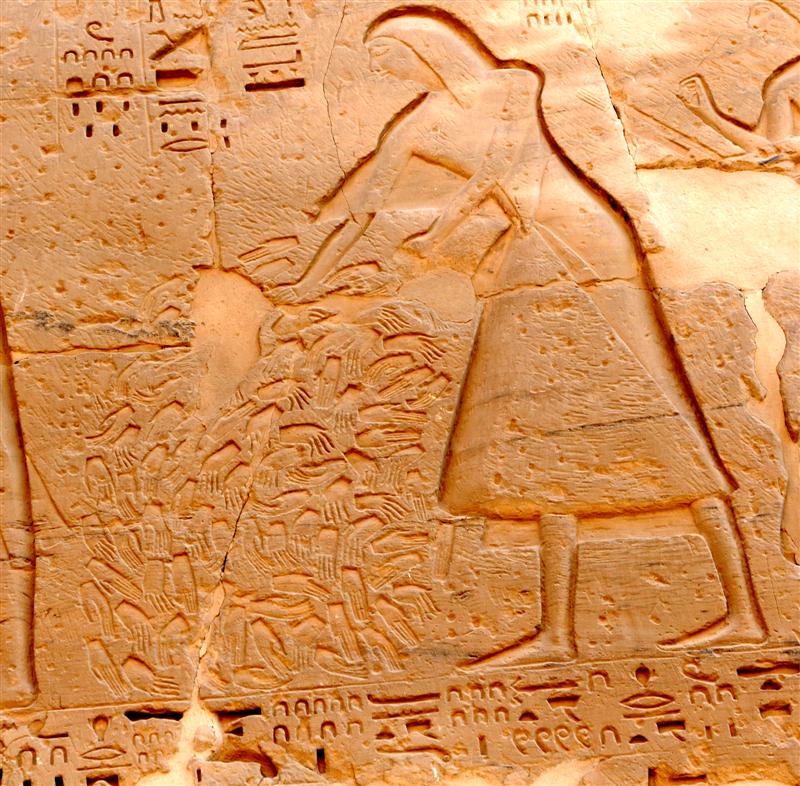
Not Bad For An Old Paint Job at Habu Tossing Severed Hands at Habu
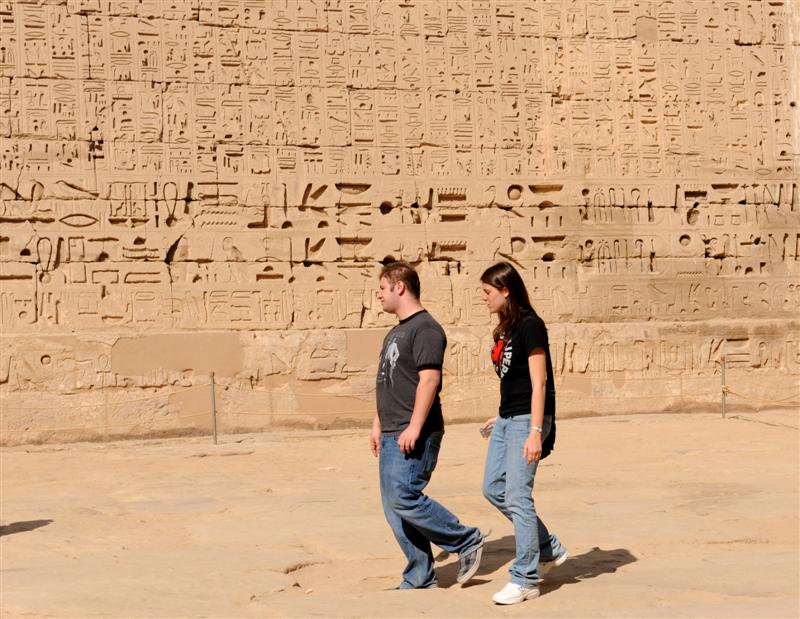
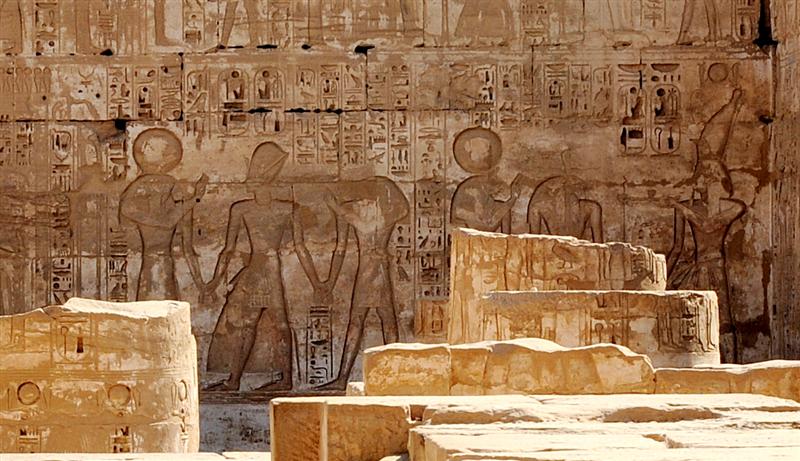
Walking in The Court Yard More Well Preserved Details In The Walls At Rear Of Complex
Many scenes depict Ramses III winning in the battles over the ‘sea peoples’ and Libyans from the west. The most accessible outer walls have large reliefs of him “smiting his enemies”. It is easy to “overload” on temples while touring Egypt, but in this instance, the Habu Temple is most memorable for the incredible brilliance of the colors of the scenes. The paint on many of the walls, ceilings and pillars are far and away the best we had seen in Egypt. The Egyptian travel website indicates that Habu Temple is one of the most overlooked sites in the area. Tour groups usually do not squeeze in this temple on the full day. If you go to Egypt, we certainly recommend that you instruct your operator to include Habu Temple! Another pleasant surprise at Habu Temple was the availability of a great lunch directly across the street. The food here was a welcome change from our standard Egyptian fare. Our group ordered different casserole dishes along with a baked egg dish which our guide Amani recommended.
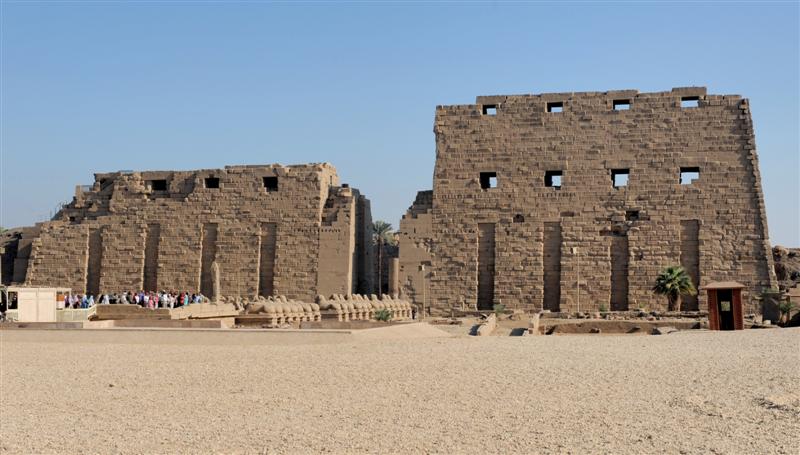
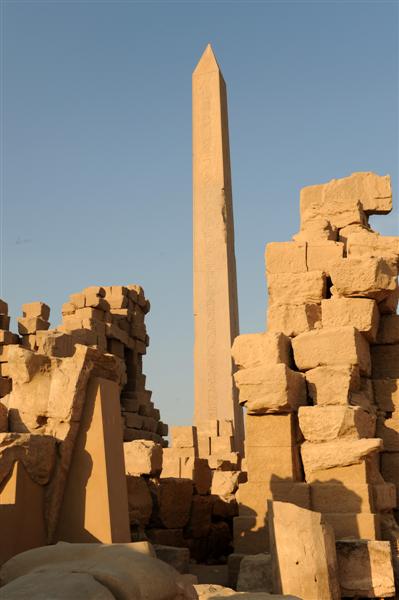
Karnak Entrance One Of The Obelisks
Onwards to the Temple of Karnak! This is the second- most visited site in Egypt (the pyramids at Giza are number one). This temple covers 247 acres and is known for its size (and the number of years required for its construction). Karnack’s construction started over 2,000 years ago. Construction continued through the reigns of thirty Pharaohs, with each adding their own additions thereby securing and expanding their own legacies. Karnack has many well-preserved reliefs including those of the Pharaohs Tuthmosis III killing his enemies, Ramses II making offerings, and Seti I driving his chariot.
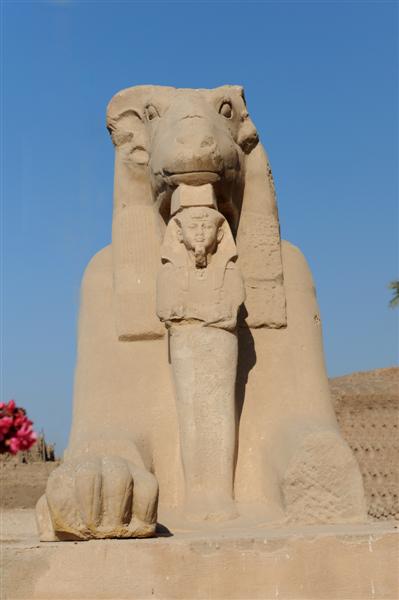
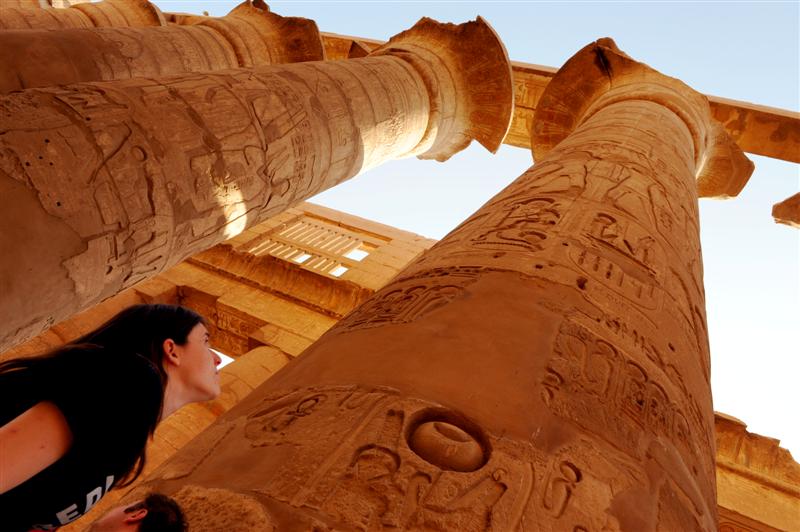
Sphinx and Pharaoh Looking Up At One of Many Karnak Pillars
The Hypostyle Hall at 54,000 square feet and 134 columns arranged in 16 columns is said to have been the largest religious structure built in the world, and whose construction was overseen by three Pharaohs. It also has one of the world’s largest obelisks, reaching skyward 96 feet and weighing an estimated 325 tons. There is also another obelisk which can be closely examined because it is laying down. Toward the back of the site is a building which was converted to a church around 356AD.
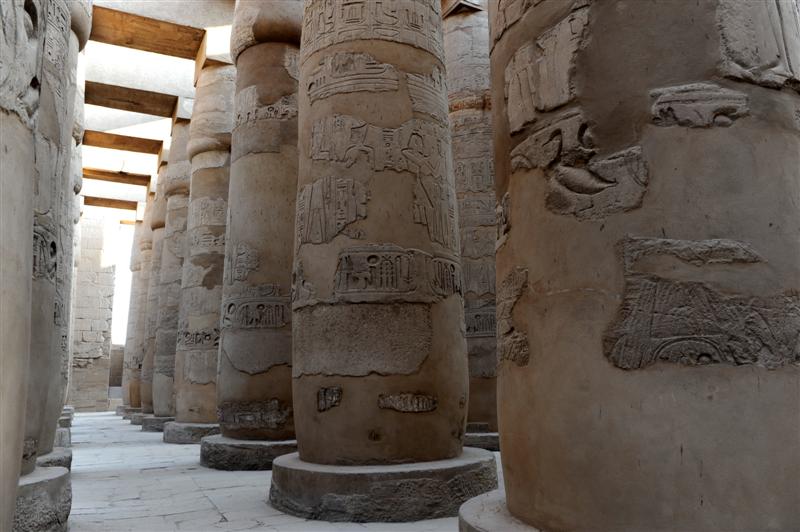

Pillars At Karnak Outside, City of Luxor
Karnak is very large and appeared to be more in ruins than many of the other sites when observed from a distance. However on closer inspection, many of the carvings in the walls and pillars appeared as if they were done a few years ago rather than thousands of years ago. We spent two hours at Karnack and this was enough time to tour the site fairly thoroughly. We were lucky to arrive when we did because by the time we left at 4:30PM the parking lot was packed with over 100 buses!
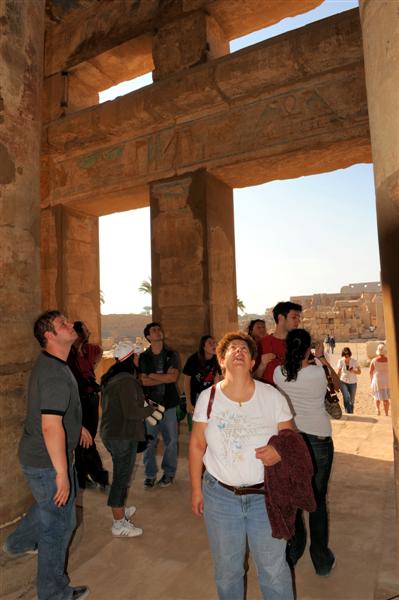
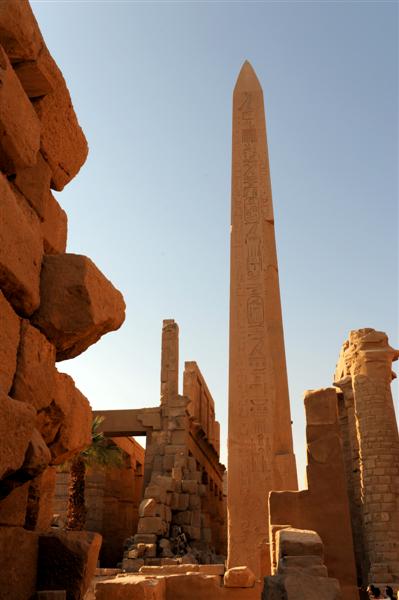

Ruined Church Converted From Temple Obelisk Near Center of Karnak Columns and Tops (not painted undersides)
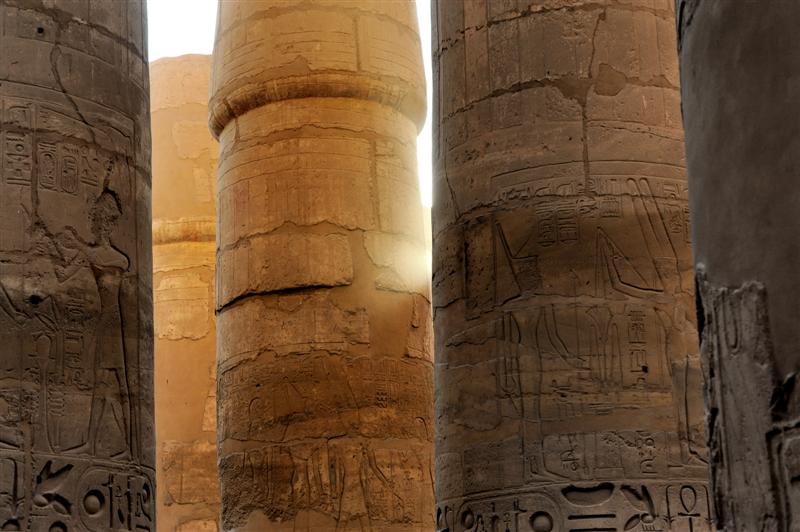
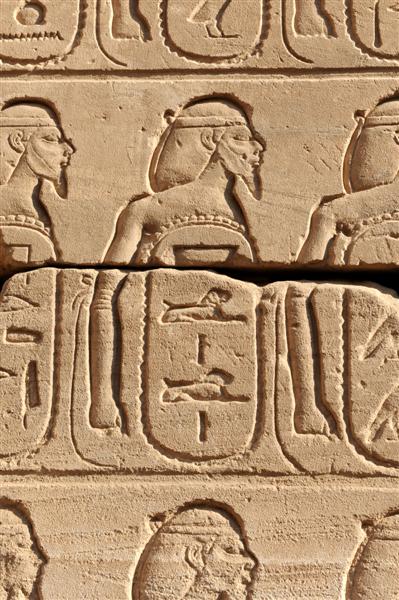
The afternoon light bleeding through the columns at Karnak was pretty From One of the Walls
The last stop of this very full day was Luxor Temple. Luxor is located just off the Nile and across the street from the souk which we visited the night before. Luxor Temple was built in 1400 BC. It has the unique spiritual distinction of housing both a mosque and a church on the same grounds! The reason for this according to Amani, is the legend that Moses in antiquity studied here after becoming the adopted Prince. The mosque entrance is at least thirty feet higher than ground level. The mosque entrance was built over the ruins of a pharonic temple which had been covered by layers of sand and silt.
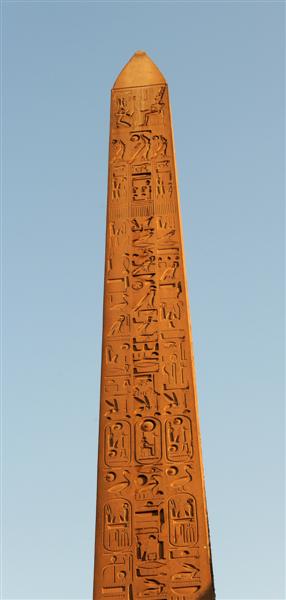
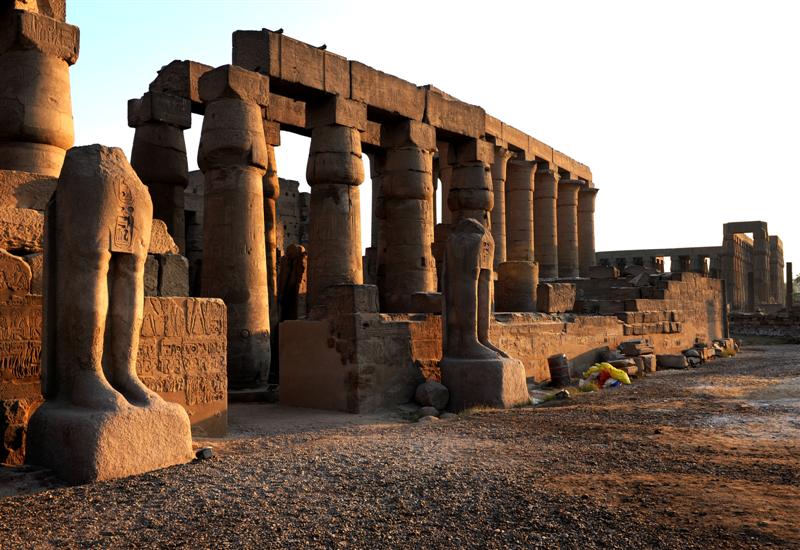
Sister Obelisk In Paris Riverside of Temple Luxor
Excavation and clearing of debris has been done to reveal the base of the pillars and statues where the original ground level was, and it can be clearly seen that anyone leaving the mosque through this main door would have had quite a drop. The front entrance features a wall with statues of Ramses II and a pink granite obelisk. The wall has battle scenes from Ramses II, as well as other battle scenes from other Pharaohs. The obelisk is one of a matching set. The missing obelisk that stood in front of this temple for centuries is now in the Place de la Concorde in France. Inside the temple complex we saw different bas relief's, friezes and statues decorated by different Pharaohs including King Tutankhamen. There is even a section built by Alexander here.

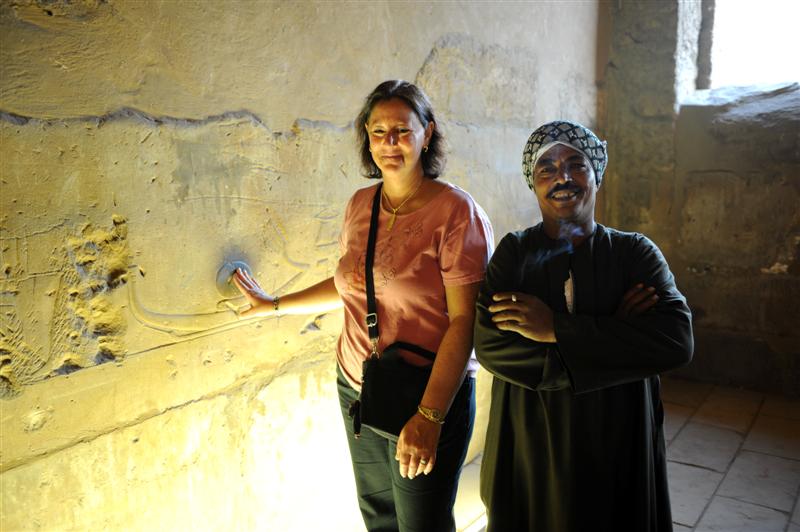
Luxor Before Sunset Maureen Touching "lucky" spot with local
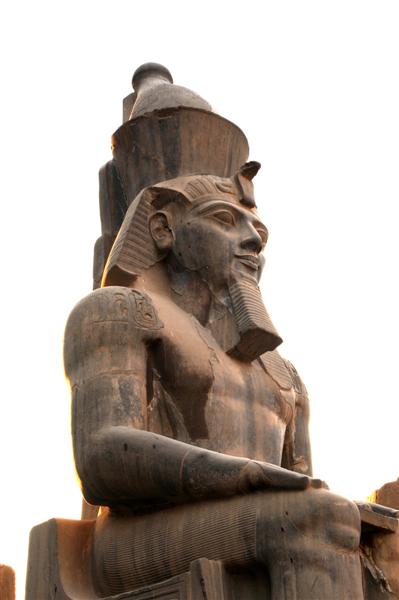
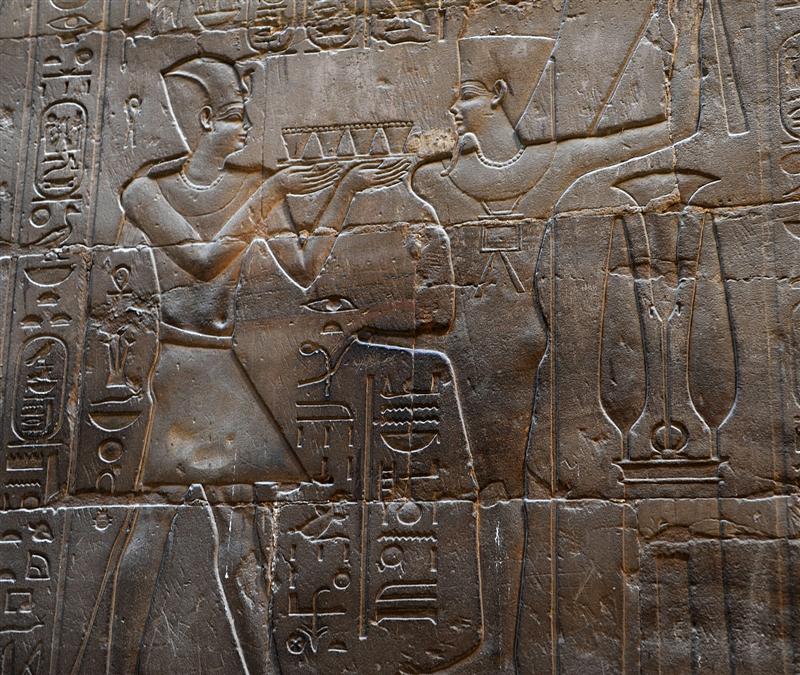
King Tut at Temple Luxor Fertility God
We explored the different rooms and upon reaching the rear of the complex saw church paintings in a corner covering the ancient hieroglyphics on the church ruins. In one of the back rooms there was a carving in the wall, which a local insisted on taking us, declaring that if we touched it and kissed our spouse, we would have good luck. (This profound mystical insight cost us of course another Egyptian pound) After thoroughly touring Luxor Temple we enjoyed some freshly squeezed orange juice and tea in a café on the grounds overlooking the entrance. The sun was setting in the background, transforming the sky from dark blue to indigo to black while the front of the Temple became aglow from the dramatic ground lighting … Magic ! Before leaving the site we strolled to a street with a view of sphinxes , which were all lit up as well. Luxor Temple was a great way to end our trip on the upper Nile before heading to the airport and returning to Cairo.
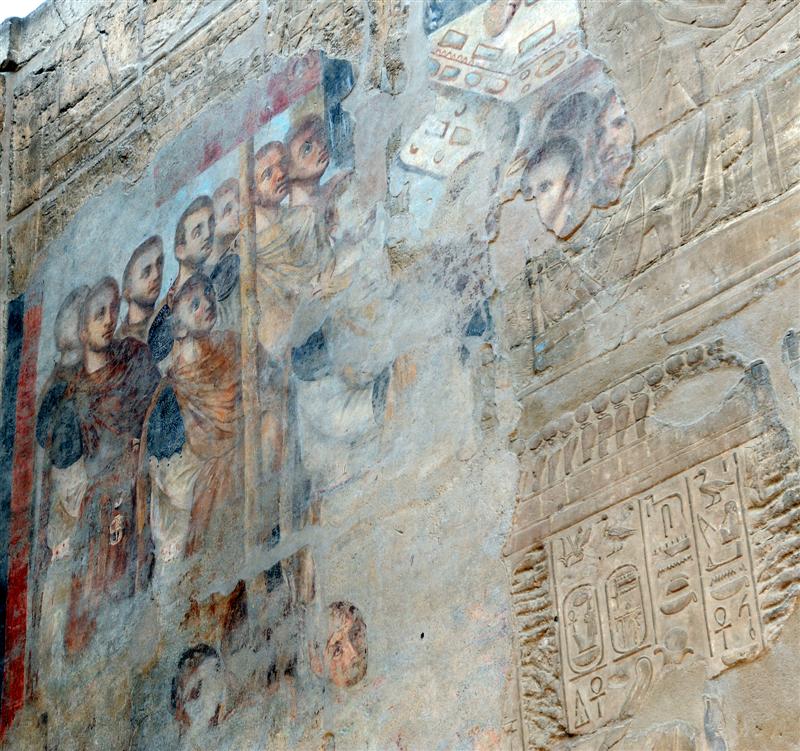
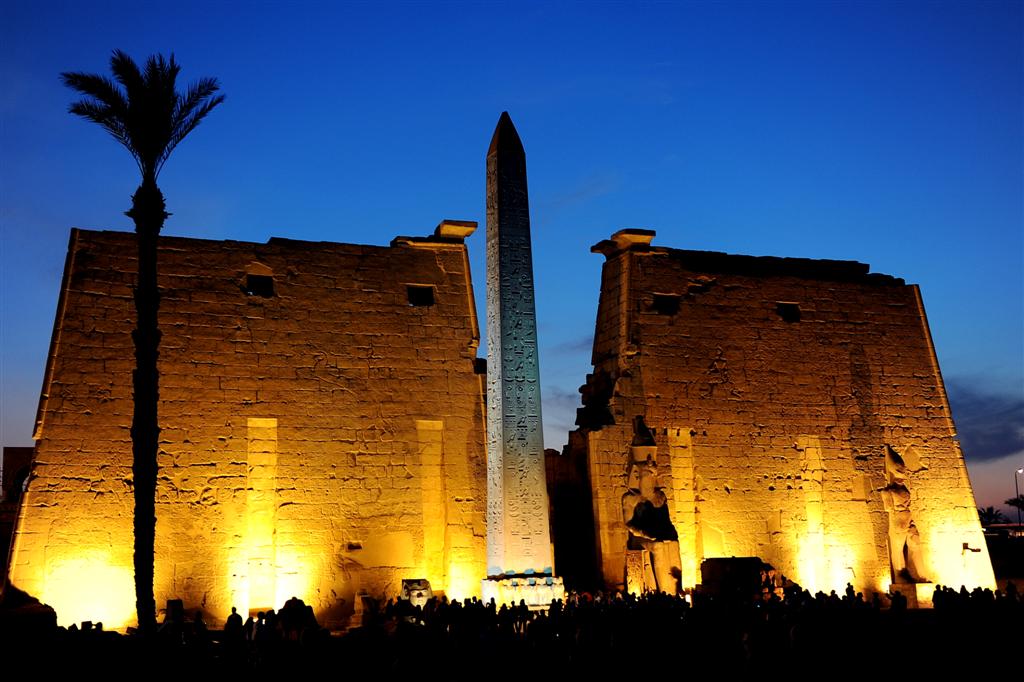
Worn out Church Painting Over Hieroglyphics Temple Luxor After Sunset

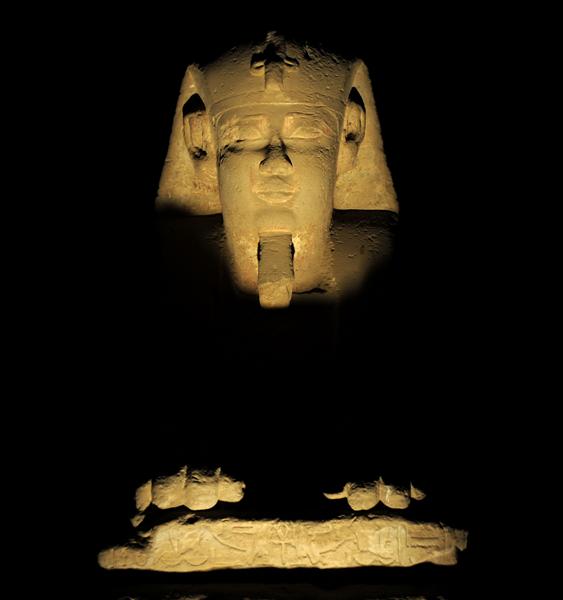

Sphinx Street Temple Luxor
We decided when planning this trip that our last full day in Cairo would be set aside as a “free day”. We reckoned that we would scope it out once in country, and then decide how we would spend our last day. After consulting our guide book, our guide and my daughter’s Egyptian friends we decided on seeing Memphis, then Saqqara, repairing to the souk for lunch, and finish up by touring the old synagogue in Coptic Cairo. (So much for this being a ‘day at leisure’ !) Our first stop was a quick one at the Mit Rahina Museum in what used to be Memphis, the ancient capital of Egypt. The highlight here was a 33 foot statue known as the Colossus of Ramses II. This statue lies sideways in a small covered building that was constructed around it. The statue is in excellent condition and shows Ramses II as a strong, young and confident looking Pharaoh bare-chested, and ready for action complete with dagger in his belt. There are also two alabaster statues on the grounds amongst various pieces of stones that are not essential to see. If you are on a really tight schedule, you can strike this museum from a busy itinerary.
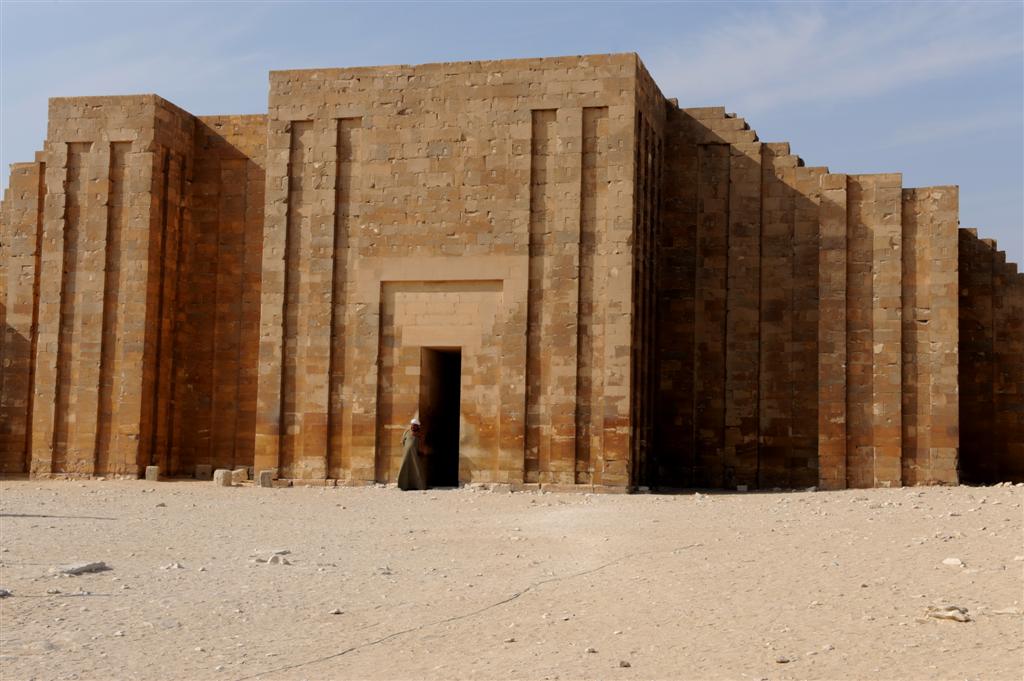
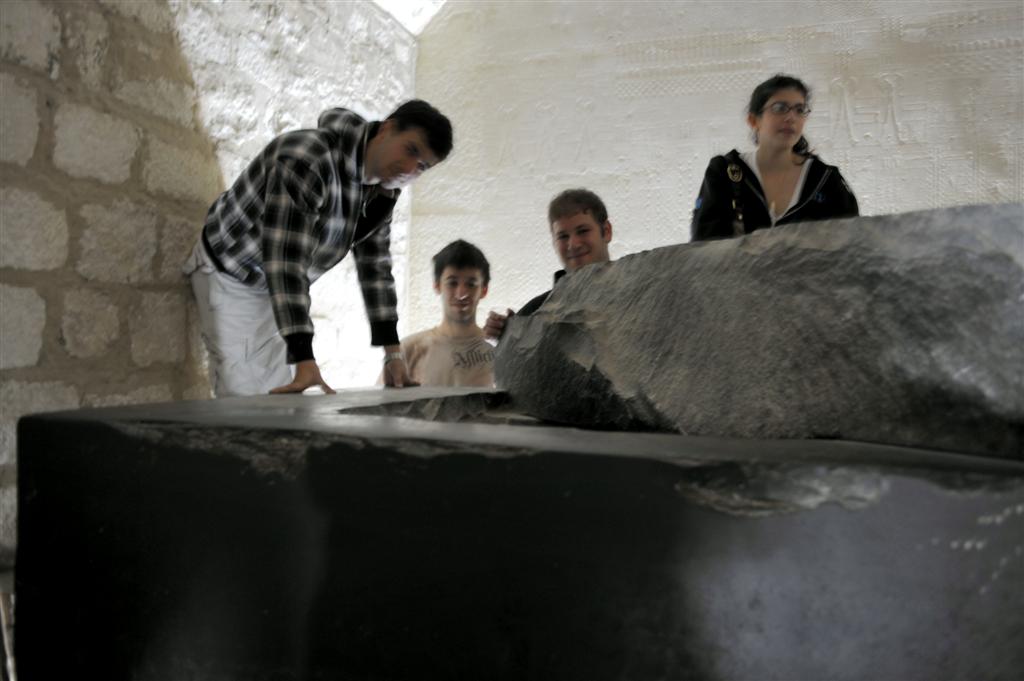
Saqqara: The Serapeum or Large Funerary The Kids Inside A Tomb Underground Over 4000 Years Old
Our last day continued with a short drive to Saqqara. This famous site boasts the world’s oldest pyramid. What did it look like? Picture the pyramids at Giza with only 5 large steps and no point at the top of the triangle – truncated as it were. This is also the site of some mastabas, as well as serapeum. A mastaba is a low-rise structure with angled walls which in antiquity was used as a tomb; a serapeum is the large funerary complex which was located opposite the step pyramid. We felt the highlight of Saqqara was the pyramid. It dates back to 2667 BC, and is the oldest stone structure in the world. It is 200 feet high. Scholars say that this step pyramid may have been modeled on 6 levels of mastabas. It is also the first pyramid made of stone, where earlier ones were comprised of mud brick which over time degraded in structural integrity ultimately failing and collapsing in a cloud of dust.
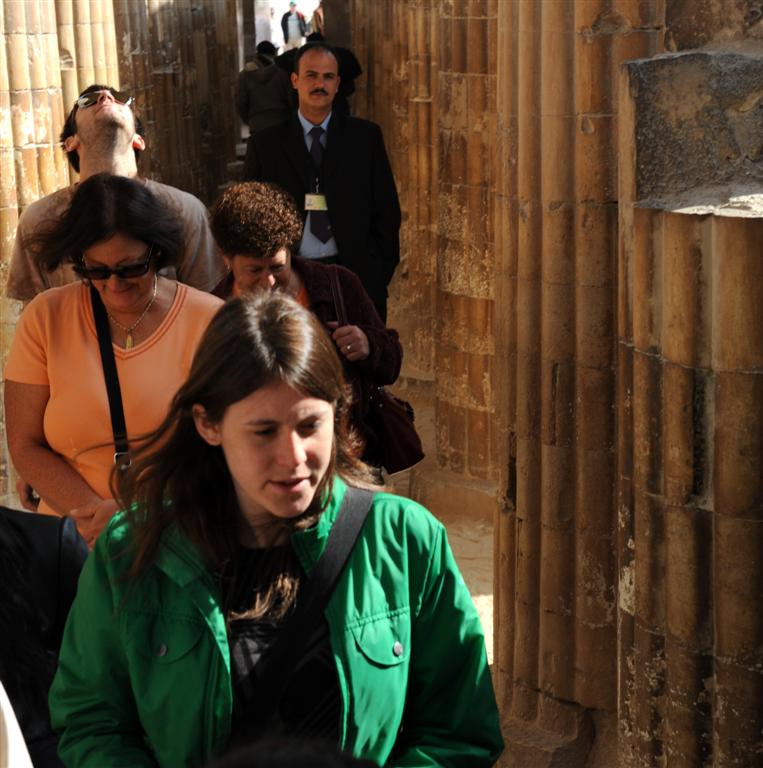
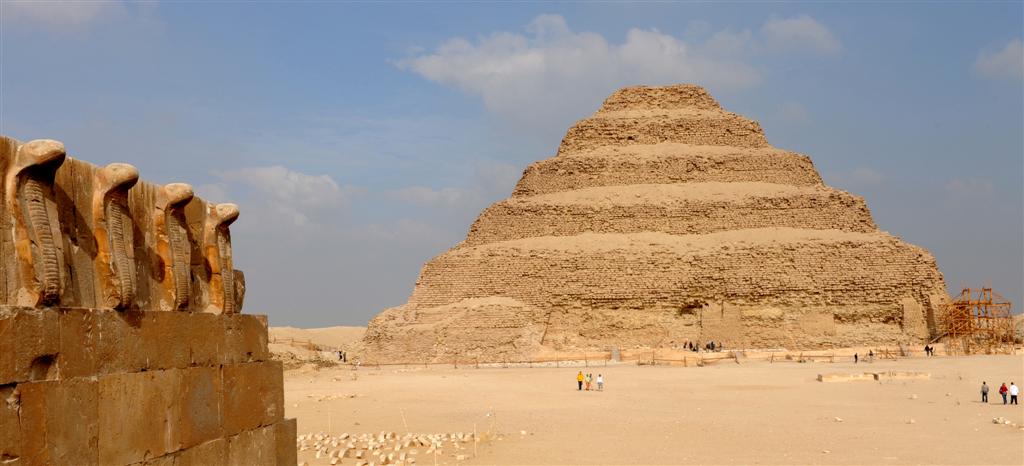
Inside Serapeum With Its Columns View To Saqqara Pyramid With Cobra Heads In Foreground
Upon arrival we were led to a mastaba and then the collapsed pyramid. In the mastaba we saw several rooms and corridors with walls very ornately carved and painted. This site (like many others in Egypt) was buried under dry sand for millennia, with the result that rooms and their contents were extremely well preserved. The scenes carved or painted inside depicted farming, details of daily life, and religious events. We then toured a collapsed Titi Pyramid. We descended steps until we observed an empty coffin of chiseled rock. We then drove to a large pyramid and funerary structure described above. At the serapeum we proceeded through a set of narrow doors and high walls, past a set of pillars and then into a large corridor. The dimensions of this space were 600 yards long by 300 yards wide with 30 foot walls and framed with forty pillars. Once on the other side we beheld the spectacle of limitless desert to the west.
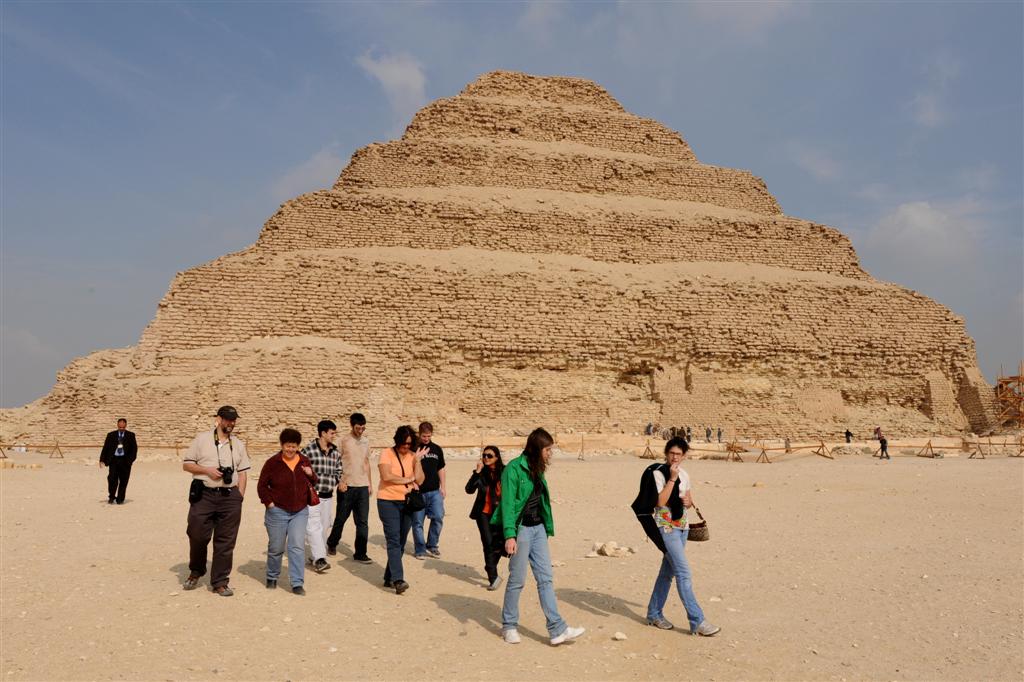
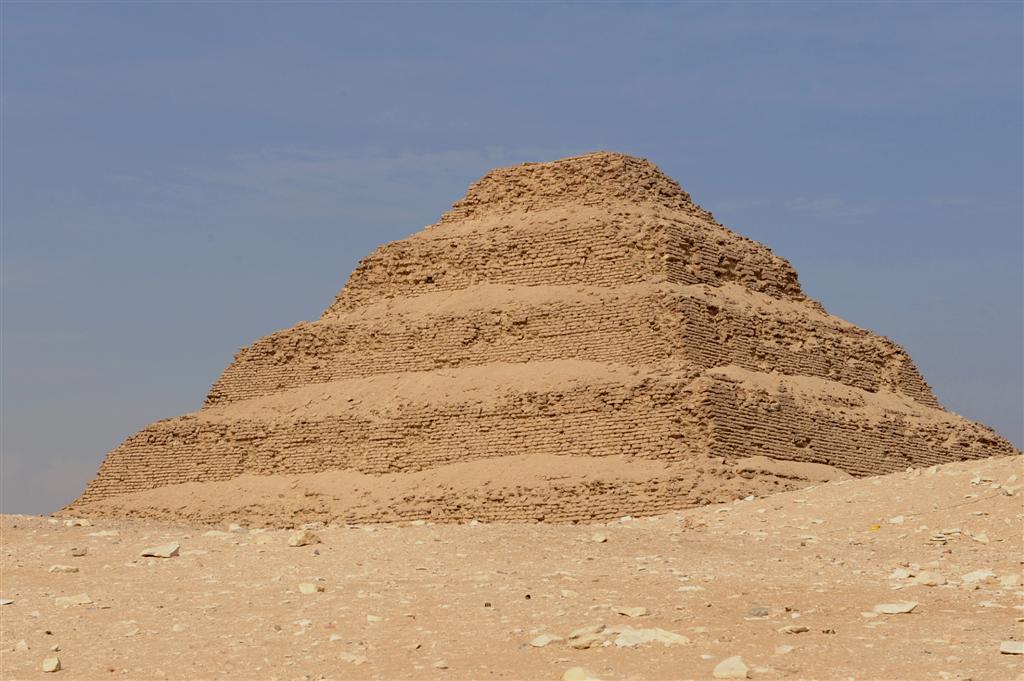
Two Views Of The World's Oldest Man Made Structure, The Saqqara Pyramid 2667 BC!
Next we proceeded across a field to get almost to the base of the pyramid, which was roped off for restoration. Here we saw several men meticulously restoring the small stones with cement, one at a time. The pyramid at Saqqara is made of much smaller and unevenly cut stones than he pyramids of Giza. After walking to both corners and further admiring this ancient structure we headed back to the bus for lunch at the Khan El Khali restaurant in the souk, and to do some last-minute shopping.
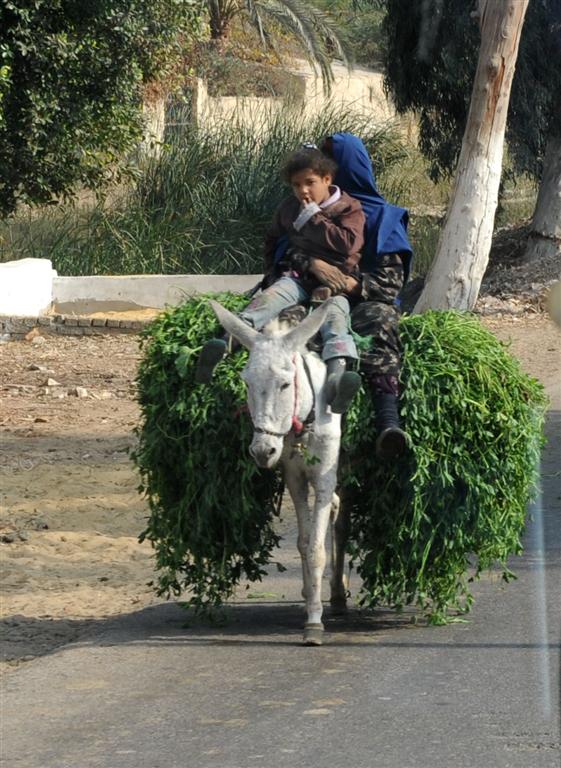
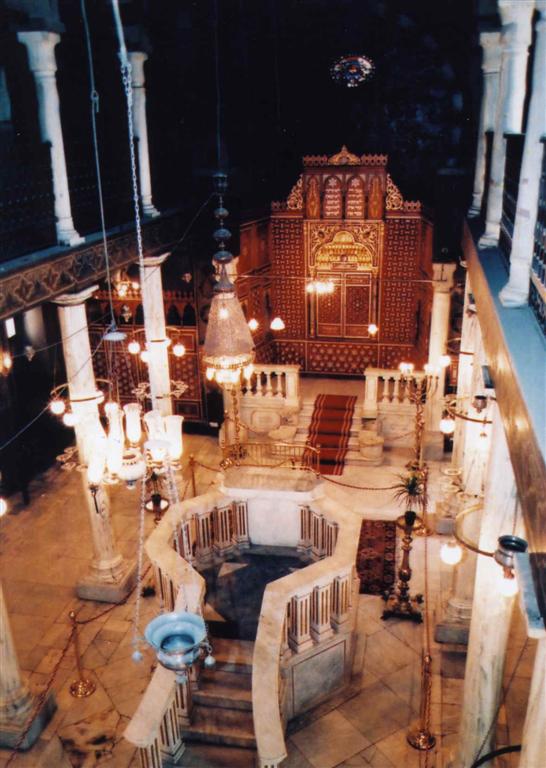
Common Form Of Transportation Outside Cairo Maureen Weaving A Rug With "Student" Postcard of Ezra Synagogue, Coptic Cairo
Then it was on to the Ben Ezra Synagogue in Coptic Cairo. Ben Ezra was originally a church built in the 4th century which was sold to the Jews in 822 AD to pay for taxes imposed by the Muslim rulers at the time. In 1892 a major renovation of the building was done in a style consistent with the original plans. It is this restored section which we see today. During restorations the geniza was discovered. Amongst religious Jews , sacred religious texts must be buried in a cemetery ; and the geniza was the repository of these texts where they were collected until such time a grave would be opened for them. Generally, the geniza also contains secular materials as well. The geniza at the Ben Ezra synagogue contained a treasure of prayer books, scrolls and documents which, taken together, revealed the fabric of everyday life in Cairo from the Middle Ages. Unfortunately we arrived at the synagogue late, with only 5 minutes remaining before closing so we did not have much time to fully appreciate it. What we did see was a traditional Sephardic/Orthodox synagogue configuration where the men pray on the lower level and women on the top floor. The pulpit was in the center with the ark on the wall facing Jerusalem. Photography was not permitted so we bought the overpriced postcards which are a major source of funding for the site. We returned to the Le Meridian hotel around 5:30PM, thus ending our “day at leisure”.



The Original Pyramid On $1 Bill Locals and Meeting Tourists At Pyramids Guard House with his 4 X 4 in Giza
On our last half day in Cairo, we opted to sleep in a bit, and arranged for our bus to pick us up at 10:30AM and bring us back one last time to the Great Pyramids of Giza. This time we decided to do the trip without our guide, although we did have another guard with us. We just felt it appropriate to return to these mysterious and majestic pyramids one last time before leaving Egypt. For me it was an almost mystical pilgrimage back to the Pyramids to say good bye. On this return visit the ‘sun god’ was on our side, with bright blue skies and a light breeze making for a perfect day to stroll around, and just relax, but also to absorb our experiences of the antiquities.
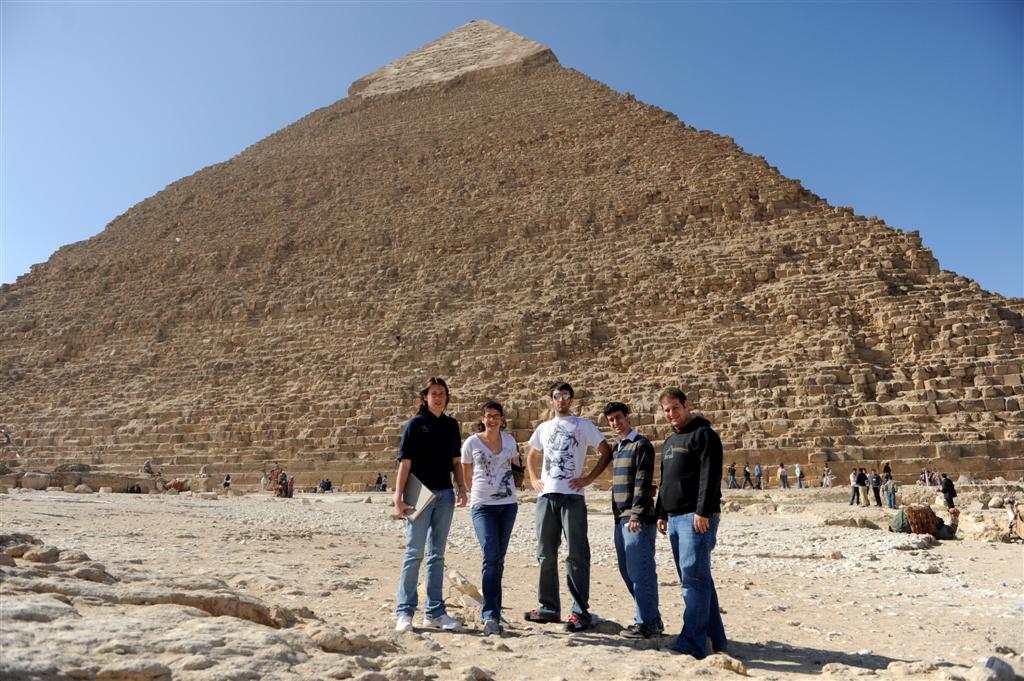
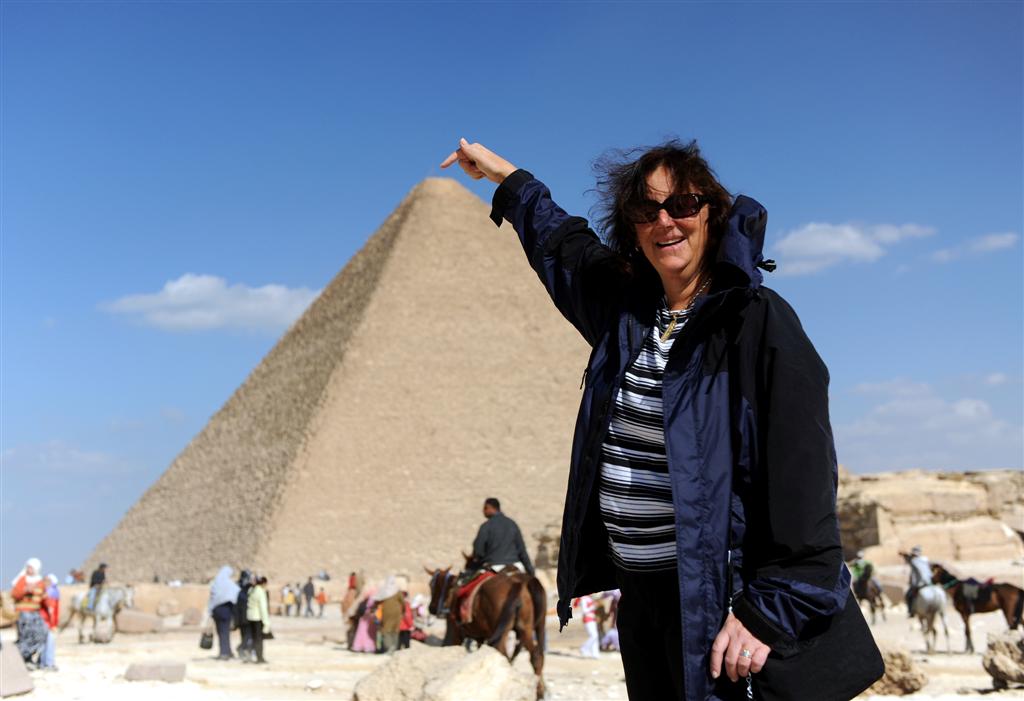
Students Having One Amazing Field Trip "Spin The Pyramid"
On this return visit we asked our driver to take us to the second pyramid. From here we walked slowly clockwise around the pyramid, taking many photographs and admiring the structure. When we rounded the second pyramid, we had a supreme view towards the Great Pyramid , with a beautiful blue sky background and we were favored with excellent afternoon lighting. We burned through many more hundreds of megabytes of images, realizing that the photographs we took during our first day would pale in comparison to these!
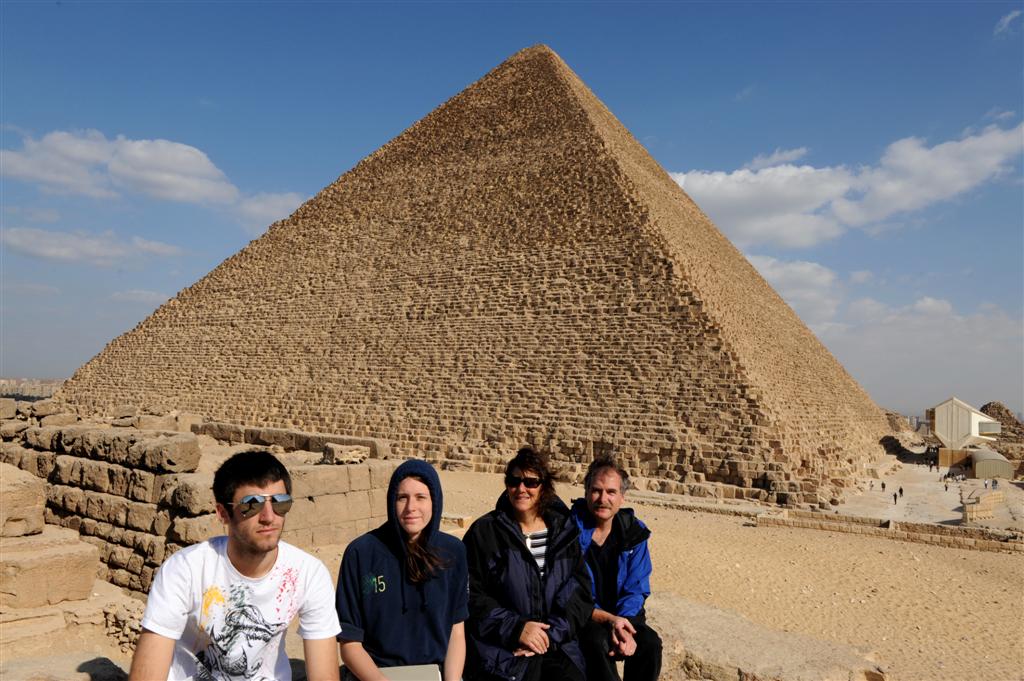
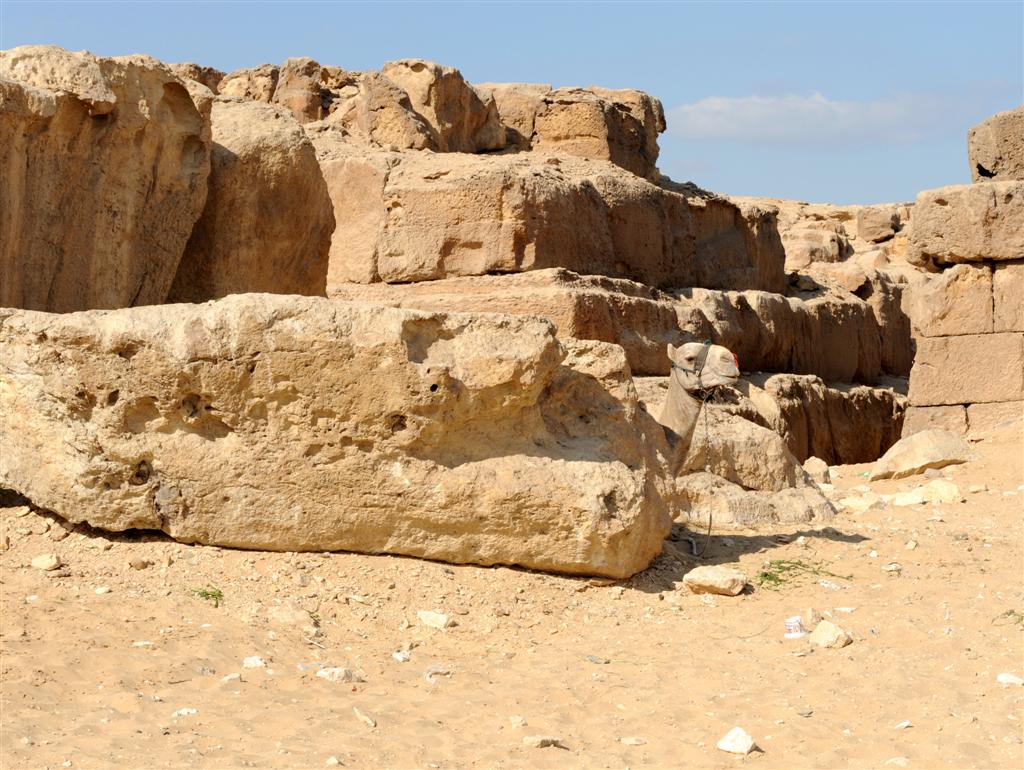
On The Way To Airport "Camelflodged"
We found a comfortable spot on the ruins to sit and just take it all in. (One funny side note -- we saw a camel’s head stick out from a large stone where we he was resting. The rock and the camel had similar colors, almost making it seem like the camel’s head was projecting out of the rock. One wise cracker amongst us commented that the beast was “camelflodged”. With that said it was time to catch our Royal Air Jordanian flight to Amman! (Starving at the airport we hit the food court with McDonald's being one of the places there. Never eating at McDee's at home some of us tried the "McArabia". This "dressed" sliced lamb like meat stuffed in a pita bread. It was not bad and it was an interesting way to see a large food institution going for local dollars)
*See Extra Pictures Below The Next Section*
IF YOU GO:
Flights (Overseas) :We found Delta’s coach class to Cairo lacking. The seats were basic. Our aircraft had poor leg room and no individual TV screens which virtually all airlines have these days for long international flights. We flew Delta because it was non-stop to Cairo and our return originally from Jordan was non-stop as well. Given a choice I would consider Egyptian Air, which I have been told has better service aboard. For travel to Israel, consider Continental. If you fly business class, it should be noted the Delta seats were not the lie-flat types that every airline uses now.
Flights (Regional) Egypt Airlines ran efficient clean planes that were on time and offered a snack for the one hour flight to Aswan and back from Luxor. Our flight on Royal Air Jordanian was a very pleasant one hour and ten minute flight in a comfortable two-aisle Airbus 340, and we were provided a sandwich. After boarding aircraft in forty seven countries and six continents I have to say that the fastest way for people to get on an airplane is just to call for the flight and board it like we did in on the regional flights. This business of boarding by rows in my view is just not efficient compared to the way most of the world boards aircraft !
Hotels and Cruise Boat: We stayed at Le Meridian in Heliopolis before and after our cruise. This was a good hotel class for the price, but is not located in a tourist- friendly area. If you want a hotel where you can come and go at leisure with shops and places to eat, you should consider staying downtown. This is likely to add about $100 to the room. An alternative to downtown is to stay in Giza. The ride to Cairo is about an hour – provided traffic moves normally. In Petra we found the Crowne Plaza comfortable. We were assigned terrace rooms with the Petra desert view. In Amman we stayed at the Le Meridian and found this to be an excellent hotel with many restaurants onsite. In each hotel the breakfast buffet was excellent and a great way to start each a long, fascinating and inspiring day !
Nile Quest was the cruise line selected by our wholesaler to cruise from Aswan to Luxor. This was a five-star boat. Our cabin was quite comfortable. The food was buffet-style with a separately- charged a la carte menu (which we did not use). The food we found to be good but they were best on the Middle Eastern themed night. I would recommend the four-night cruise over the three-night one which we did, because it starts in Luxor -- which is the place to be for the extra night. If you want to splurge there are smaller six-star vessels that really excel in service and food, but the price can be as much as thirty percent higher. If possible do not chose less than five-stars unless you are severely budget-constrained.
Security:
Being an American (or Westerner) in a moderate Arab nation causes one pause. Security is taken very seriously in Egypt. We were told that the government puts government security officers on American tour buses. The reason for this is because tourism is a major cornerstone of the entire Egyptian economy, and the government does not want anyone being hurt – which will negatively impact tourism. At first I was a little surprised to see a man on our bus wearing a business suit, leaving me to wonder just how capable the person was. I noticed a slightly larger bulge off his right hip which a Bulgarian small machine gun so we knew he was all business. During our stay in Cairo we had different guards with us. They usually tagged along behind, watching from behind. We also noticed that security was taken very seriously at each site. No one gains access to a tourist site or hotel without getting bags X-rayed and being checked through a metal detector. Tourists may get waved through if the metal detector beeps, however locals will be more scrutinized. We also saw evidence of security in the souk in Cairo, where security personnel would walk around the main square and check behind the benches with a clip board documenting where they were. There were also the “tourist police” stationed about every fifty to seventy-five feet there as well as on the corners of our hotel. This is in an effort to thwart attacks similar to the attack of 2005. Unfortunately it was only about 6 weeks later from our trip did two small bombs get thrown into the square killing a French High School girl and wounding her classmates and 3 Saudis. One hand made bomb fortunately was a dud. Caution and paying attention is the word here so pay attention to things. At Abu Simbel we traveled in caravan with a soldier on board each bus. In Jordan we did not have the personal security, but did have adequate hotel security. Israel has the most relaxed security of three countries. There were guards outside every coffee shop and hotel, but like the one in front of our hotel, they seemed mostly interested in studying or reading. It was interesting to note that the hotels we stayed at in Egypt and Jordan all had barriers to keep cars away from the front, but the King David Hotel has an inviting circular unsecured driveway allowing a vehicle to just drive right up to the entrance. We also did not see any display of security at the market in Jerusalem as I would have expected. There was however, visible security within the Old City and at the Western Wall. I want to make very clear that at no time did our group feel unsafe. We all felt concerned and a little nervous given the war going on in Gaza and were concerned how it might affect us if the protests got out of hand. The rule here in general is pay attention to your environment when traveling about, and to pay careful attention to the news. We listened to BBC regularly when it was at the hotel or kept ourselves posted by reading up on the Internet. BBC seems to have more reporters than any other news network and were the best. Tensions did get a little high in Jordan during our last three days there. With that said we decided to be Australians if anyone ask until we cleared the Allenby Bridge !
Using A Wholesaler:
I am the last person who likes to be on a structured tour, but there are some trips where it is recommended. We were in Egypt and Jordan to tour intensively, not sleep late and weigh options for the day! With this trip we evaluated three tour operators and compared prices and itineraries. We then fine-tuned several aspects of the trip with regard to accommodations and itineraries. We picked Dead Sea Tours in Jordan because they came recommended to us , and they were offering an itinerary similar to the U.S. tour operators but for almost 15 percent less. Dead Sea Tours in Jordan then subcontracted Wisdom Tours in Egypt to handle that section of the trip. Wisdom is a large company and they really took great care of us. We really liked the full-size bus for us to spread out in, which gave each person four seats. We had no complaints with Wisdom or our guide. In Jordan we were given a minibus sitting three across, making our long rides a little cramped. Our guide in Jordan did not seem to like taking us around, perhaps because we were Americans. I say this because he made a couple of comments during our three days together. He was also not used to touring with teenagers. We met the owner of Dead Sea Tours and found him to be a likeable person. If you use their services I would advise him about your group and make sure the guide is expected to be a reasonable fit with your expectations. Finally , if using a wholesaler or any tour group, pay by credit card! That way you will have at least some protection if services promised are not delivered. We paid a three percent credit card fee to Jordan rather than wire money in advance.
The Representative or Fixer
At each place we flew to a representative acted as our fixer. The fixer’s job was to make sure things go smoothly. This included meeting us before Customs, handling our baggage, standing online to get us our boarding passes, and even checking us in at the hotels in Cairo. This made our traveling much easier and it amounted to usually a $10 or $20 tip for the entire group for each occurrence. At Cairo Airport heading to Amman while standing near the ticket counter, my daughter asked why we would need to have someone help us when in the past we would do everything ourselves. As if almost on clockwork three men started yelling at each other at the front of the line. One of them was our representative. The guide said he was yelling at them to ensure that our thirteen bags were checked in as they are supposed to be, and not to be messed around with. I am sure there was a small tip from him to facilitate this. You certainly can travel as a family or by yourself, but having someone look after a group for a few dollars is well worth the investment!
Minor Issues and Warnings:
If you travel by yourself stay in the main tourist areas, and do not stray to the outskirts. Make sure you know what the taxi will cost in advance, and bargain. A taxi hailed by the hotel will cost more money than flagging one down in front of it. Using a hotel car will be more money yet, but may also be more comfortable than the Egyptian cabs. (We caught a forty-year old Russian Lada for the five minute ride back the hotel, and I would not want to sit in that car going any distance due to comfort and safety). With taxis it is perfectly acceptable to just give the money to the driver and walk out if he asks for more money. Always check with the hotel desk to make sure your destination is open and safe to travel to. When you go to Abu Simbel be absolutely sure that the tour is arranged with your boat or hotel.
Do not drink any tap water and avoid brushing your teeth with tap water in Egypt. It is also advised not to eat unpeeled fruits and vegetables. We did cheat on this after four or five days enjoying some of the wonderful salads that came as first courses. With regards to Nile Cruising, we had heard stories of people getting sick on different boats, but we were fine on our boat.
Hindsight Being 20-20:
(Things we would have done differently if we knew then what we know now):
Our biggest mistake was not doing the four night cruise and instead selecting the three night cruise. The four night cruise gives you more time in Luxor. For Cairo if you want to splurge on the hotel room, stay at the Marriott or Hilton downtown, and then stay in Giza when you return from the cruise. Also, tour Coptic Cairo on the way to or from the Pyramids. This was a big mistake for us, which added nearly one and a half hours of bus time because we did not understand the logistics properly. In Jordan we might have passed on the Church of Madaba unless you have a compelling interest in mosaic maps on old church floors, and we might consider passing on the Mit Rahina Museum in Cairo.
If we had had a few more days, I would have considered adding Alexandria the itinerary. We might then have traveled west on the coast, where the kids could have done sand boarding. Also, if you go in warm weather you should certainly consider one of the coastal resorts on the Red Sea for some diving or down time after all that intensive touring!
Remember: A trip like this takes planning between you and your tour wholesaler. Just do not take what is offered to you unless you check it out. This way there are less surprises.
*Special thanks to my editor Gary Lehman who pushed me along to post this*
Please email any questions to tabh@hascorelays.com
Photos are property of Tab Hauser
Other Interesting Pictures

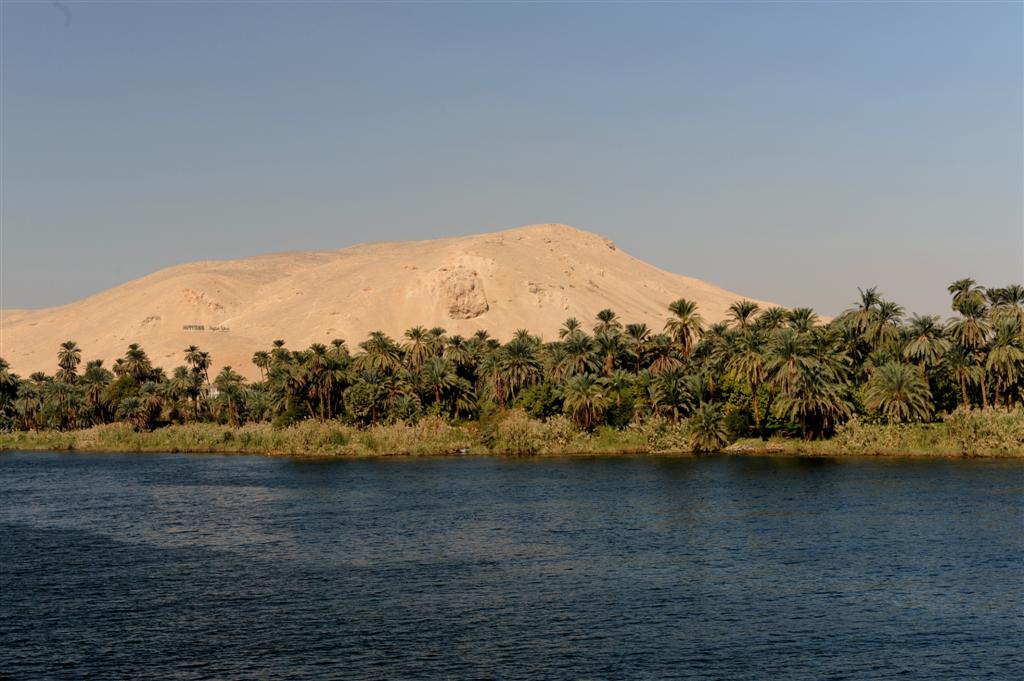
Someone is Not Dressed Properly On this cool day! Nile River Scene, Plush Verse Desert Dry
Above are Pictures from Giza Pyramid Area. CLICK PICTURE TO ENLARGE
.jpg)
Cairo Looking to Pyramids to the West
Pictures Along The Nile River Below ** Click Picture to Enlarge**
Below are Photos of Carvings and Hieroglyphics From The Different Temples. *Click Picture To Enlarge*
.jpg)
THE END, Photos Copyright Tab Hauser